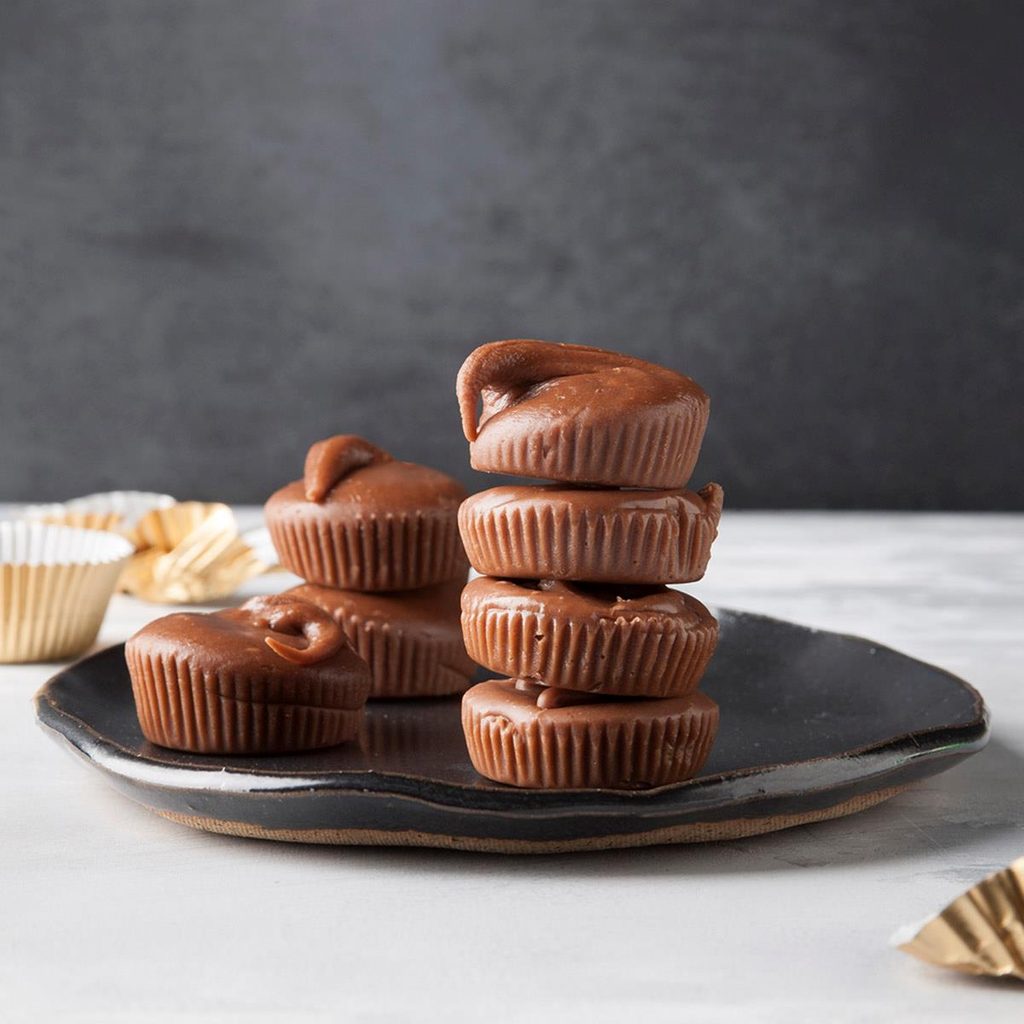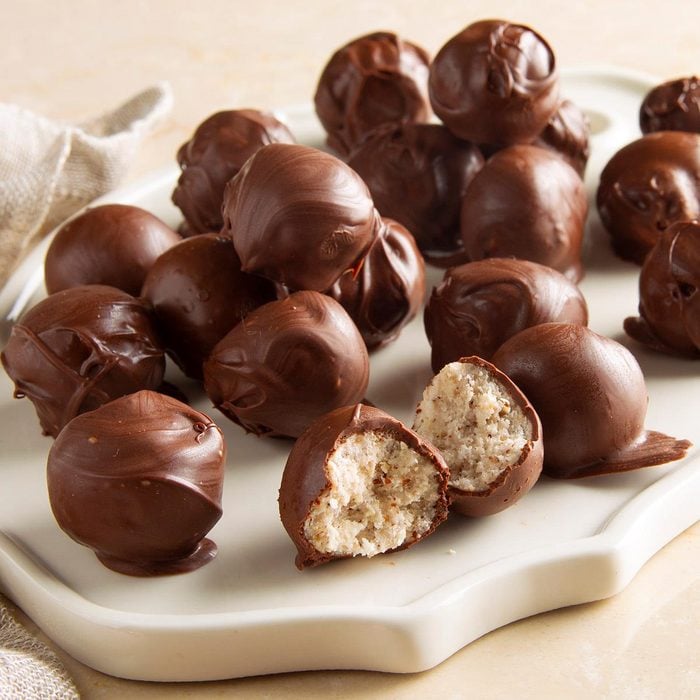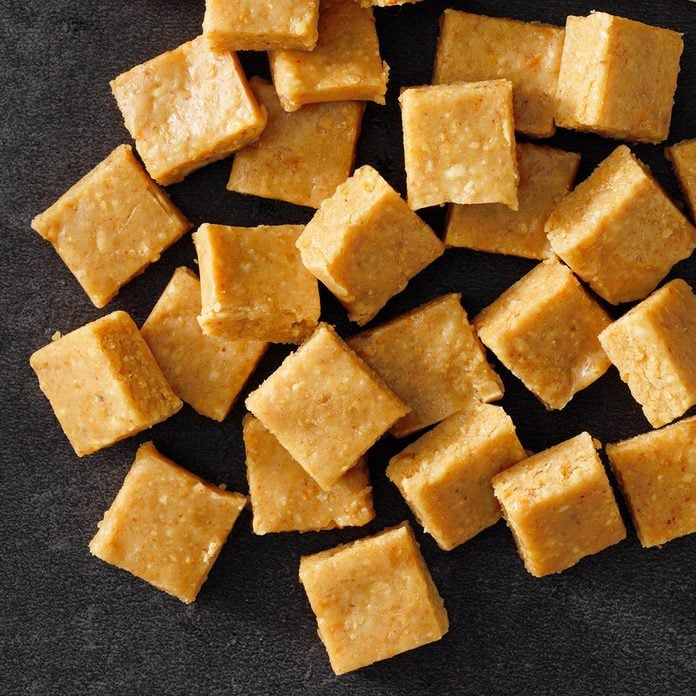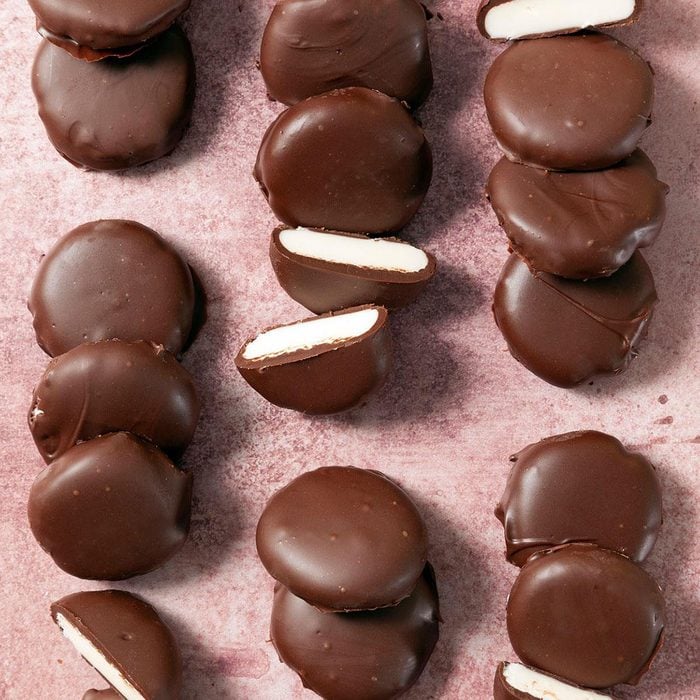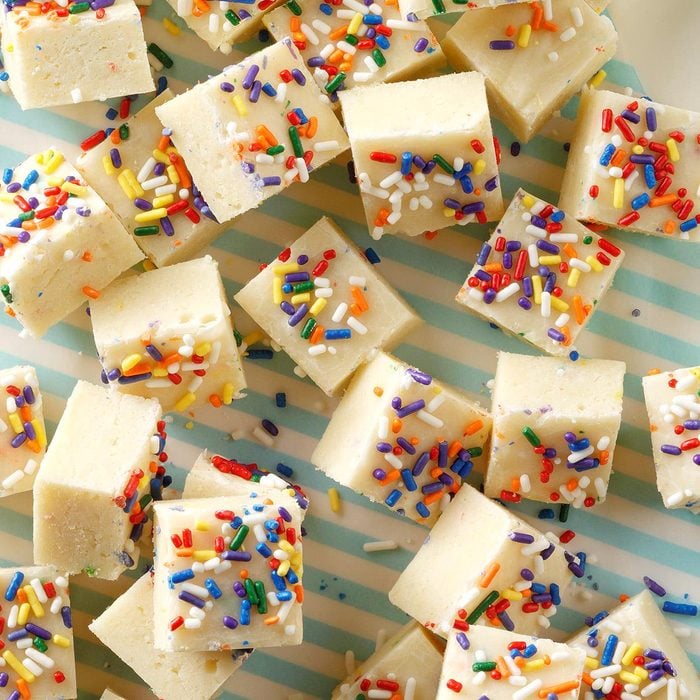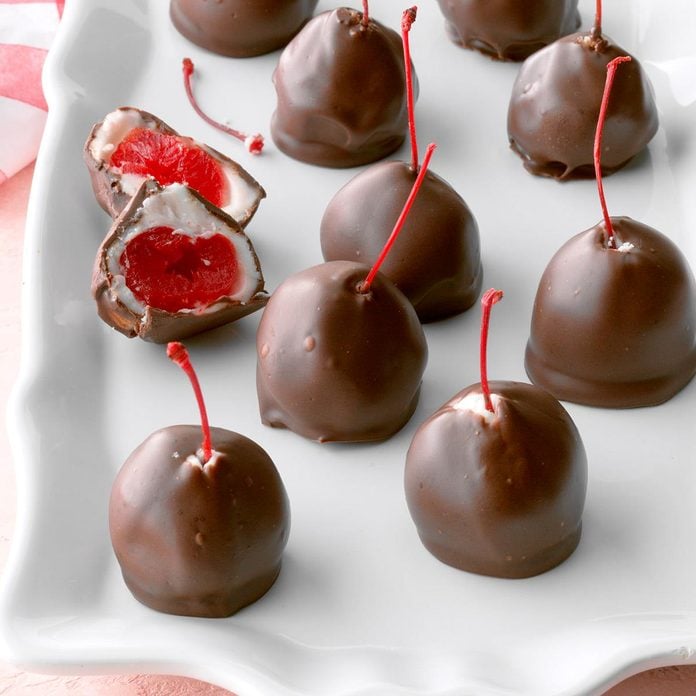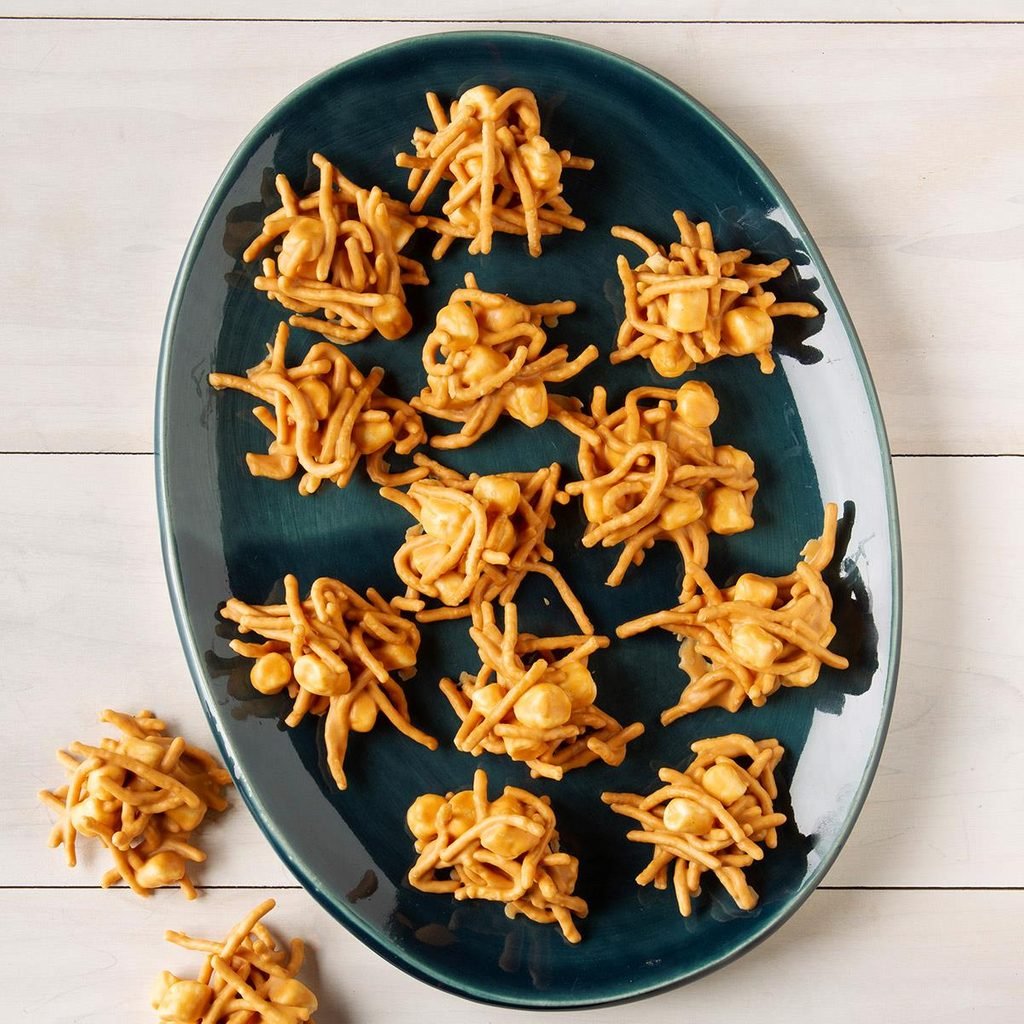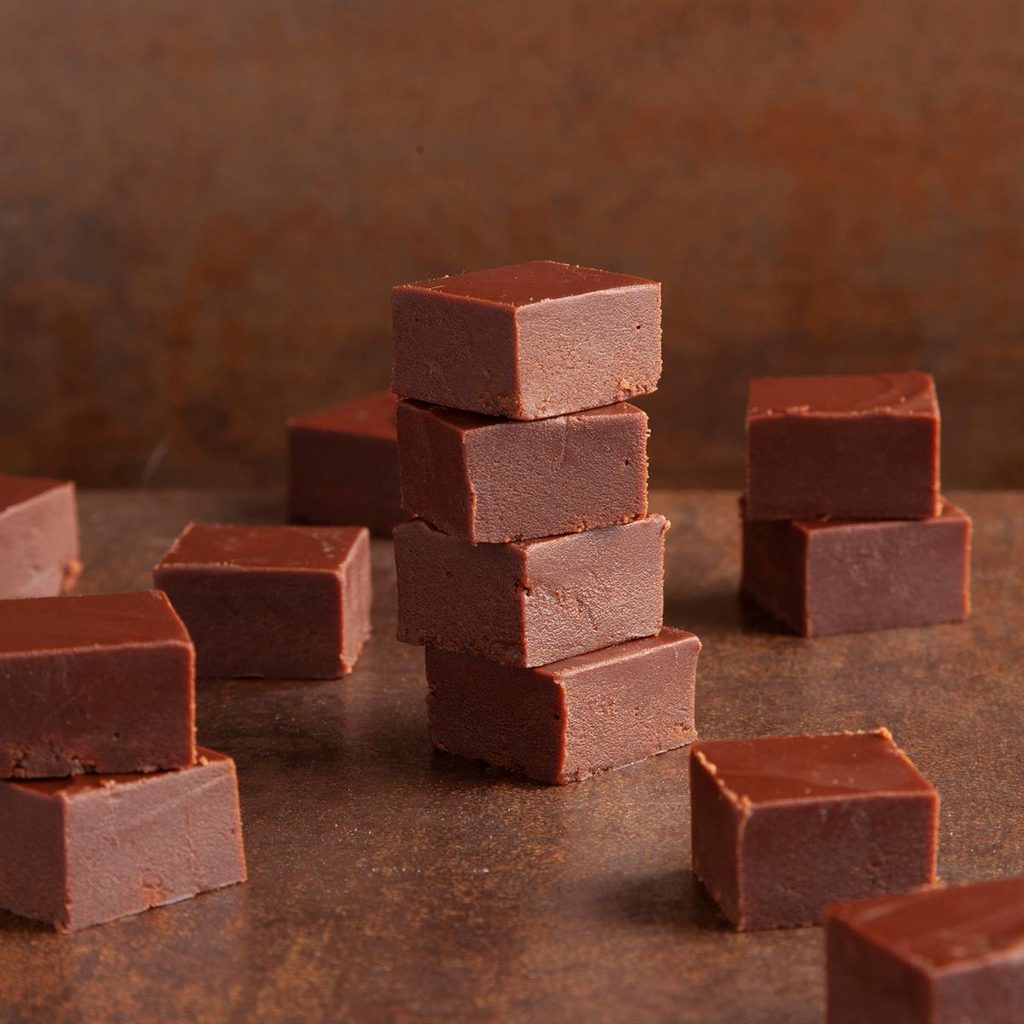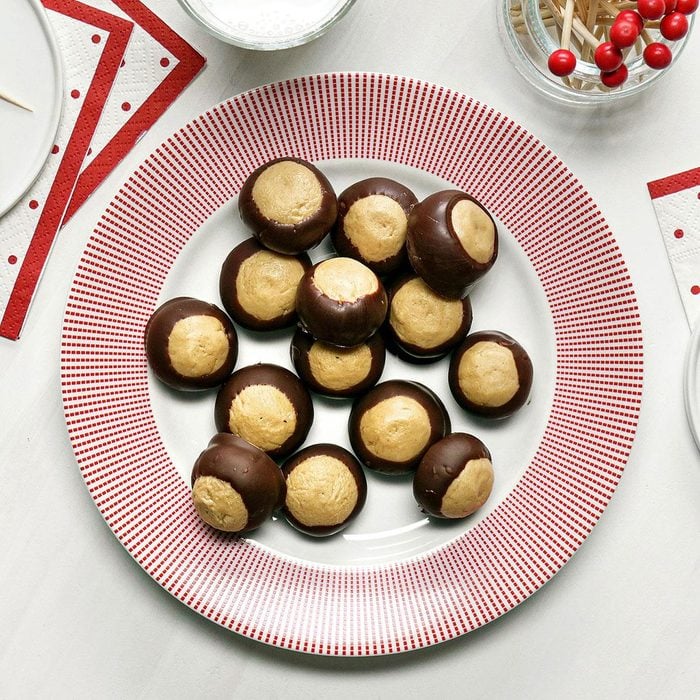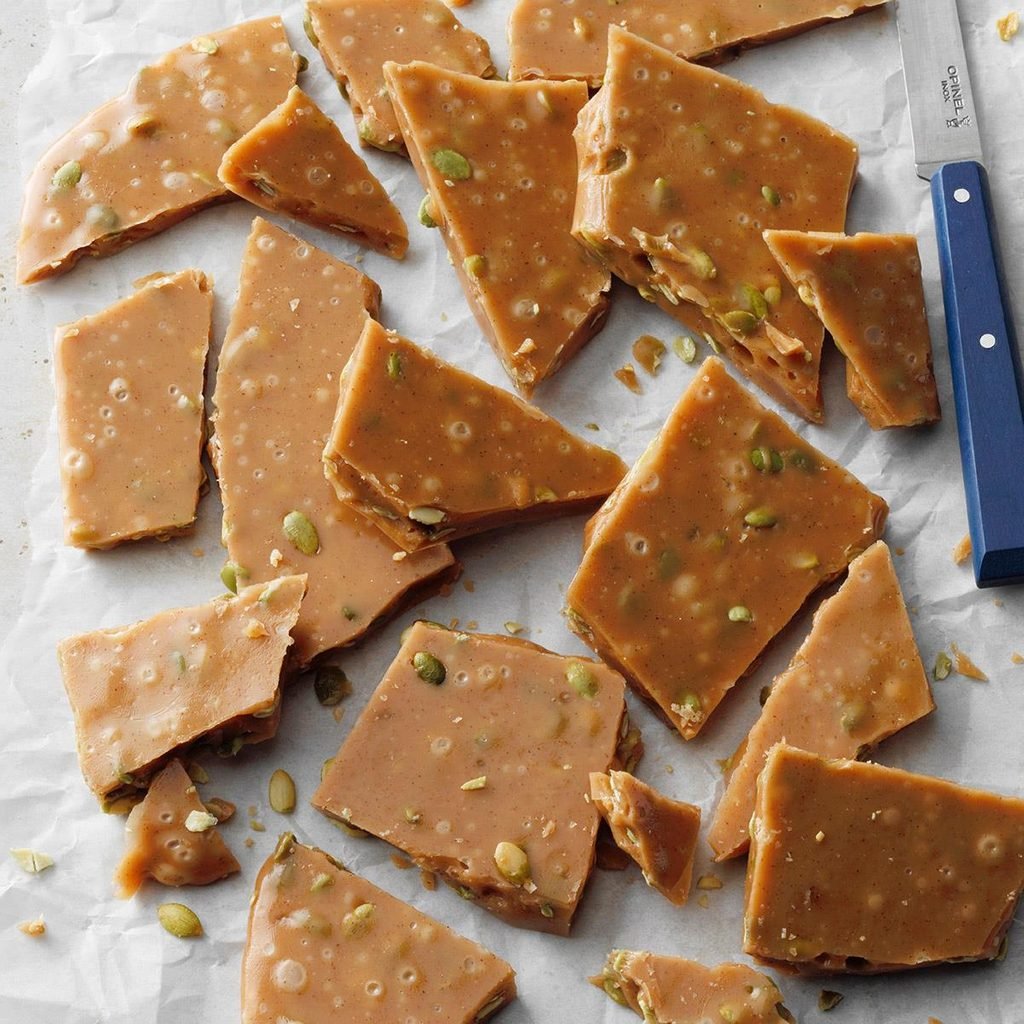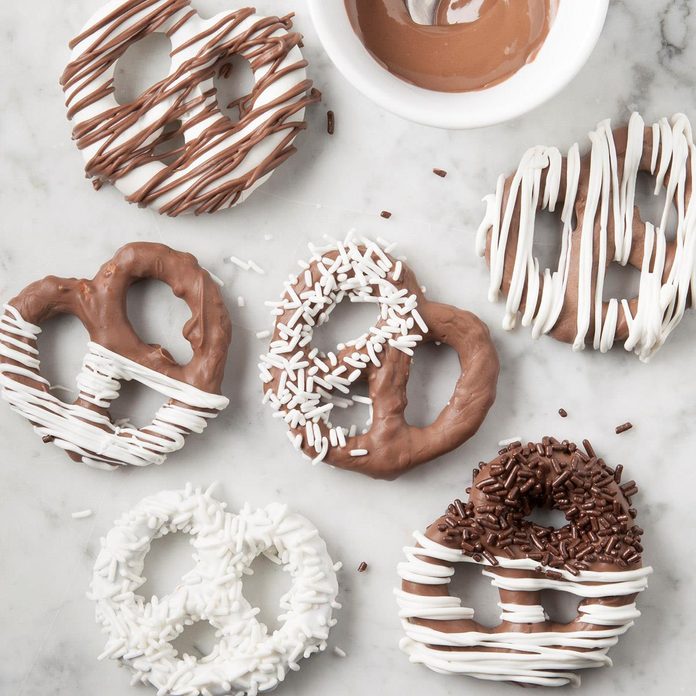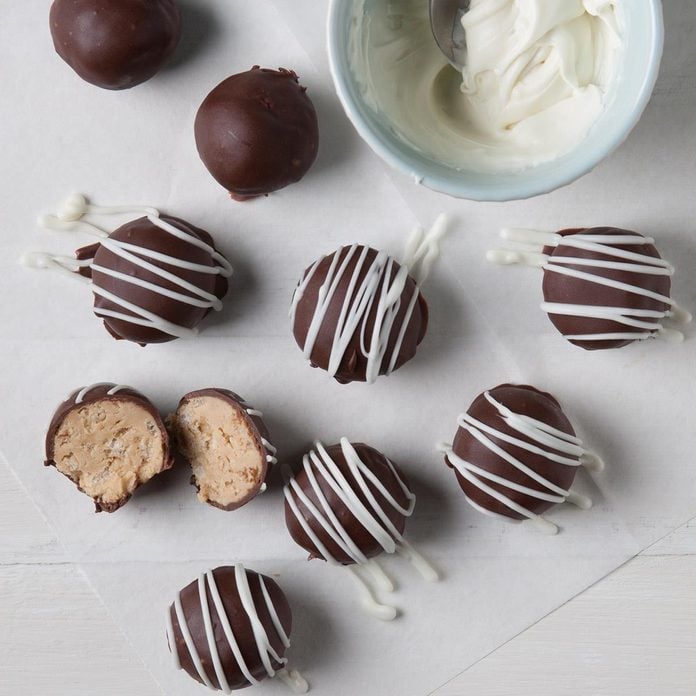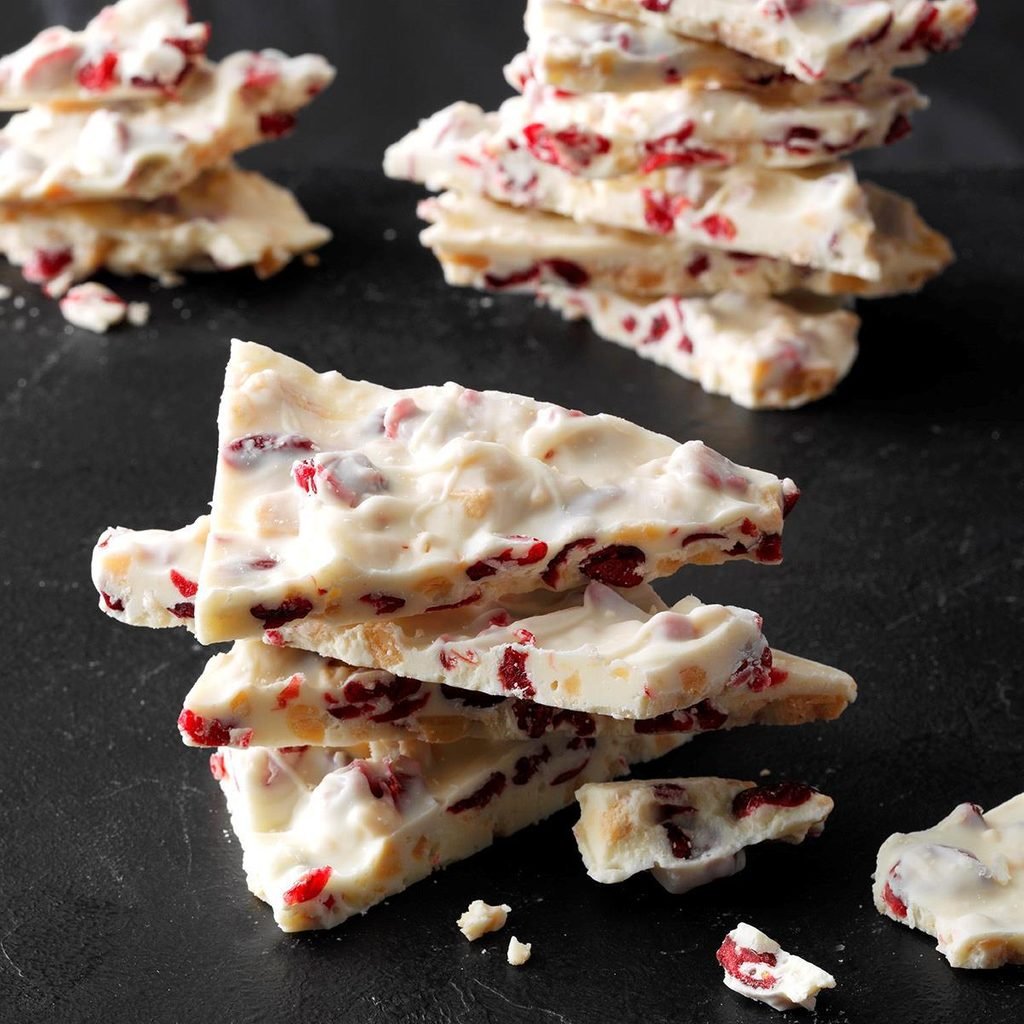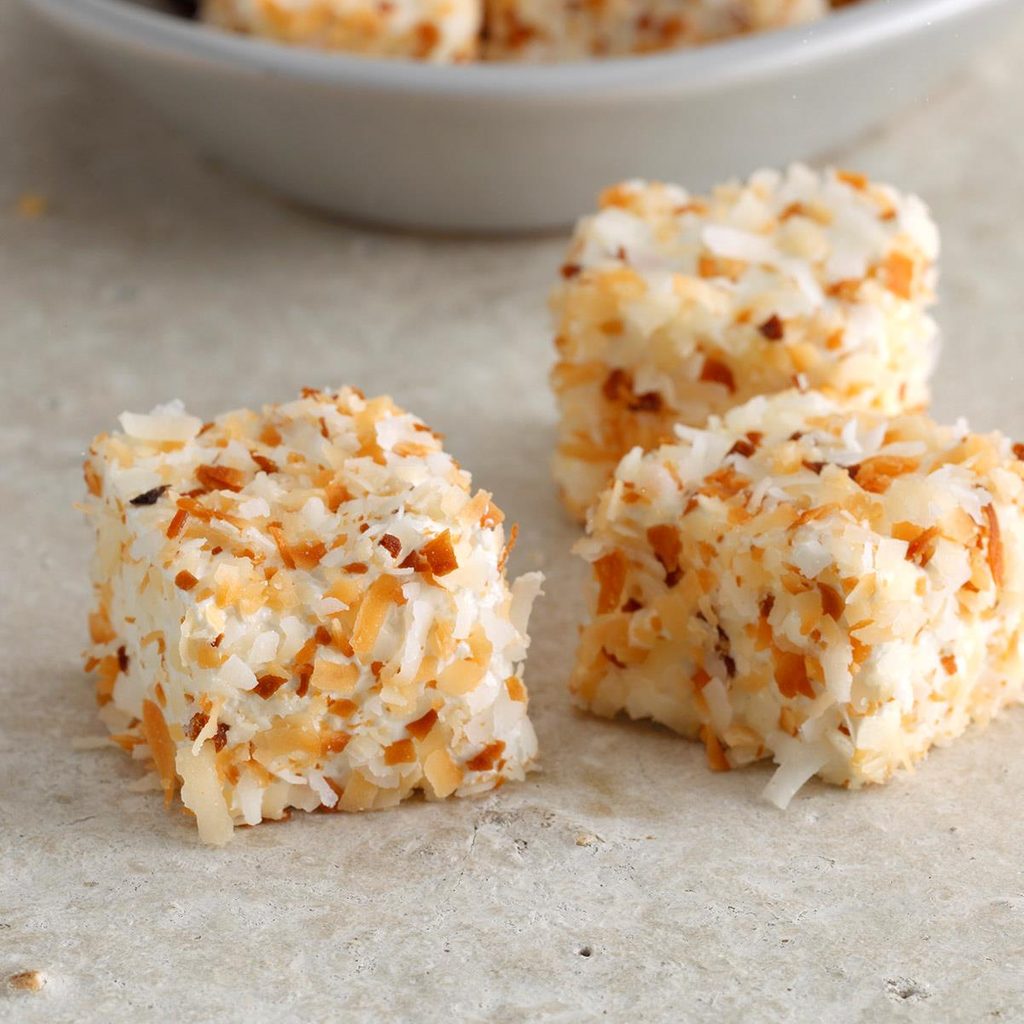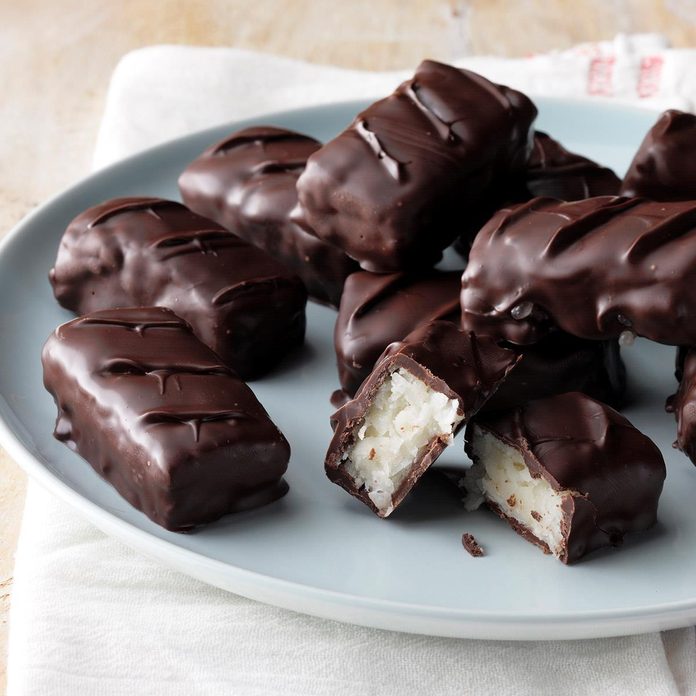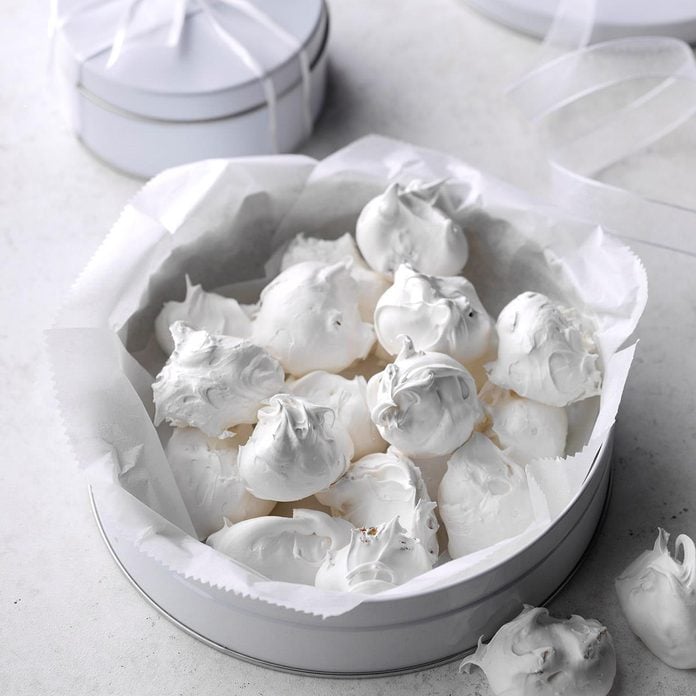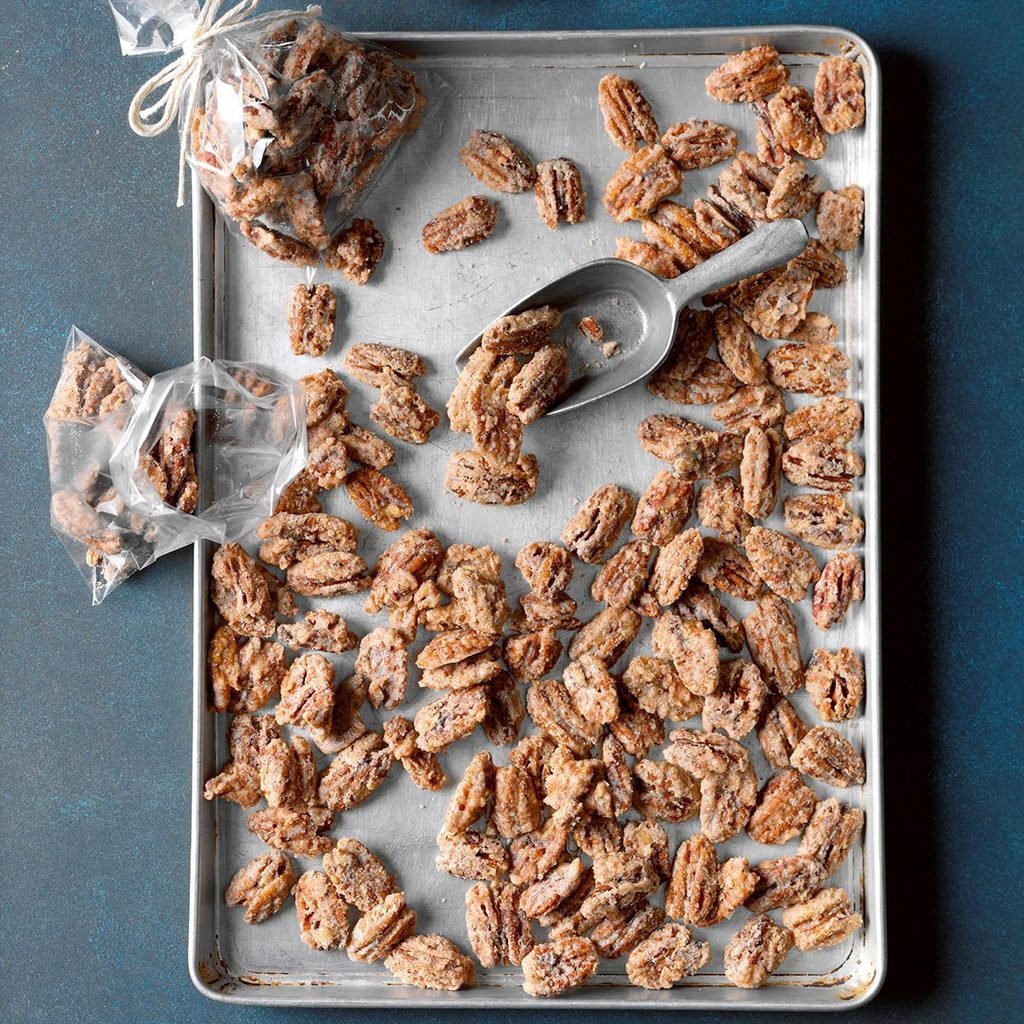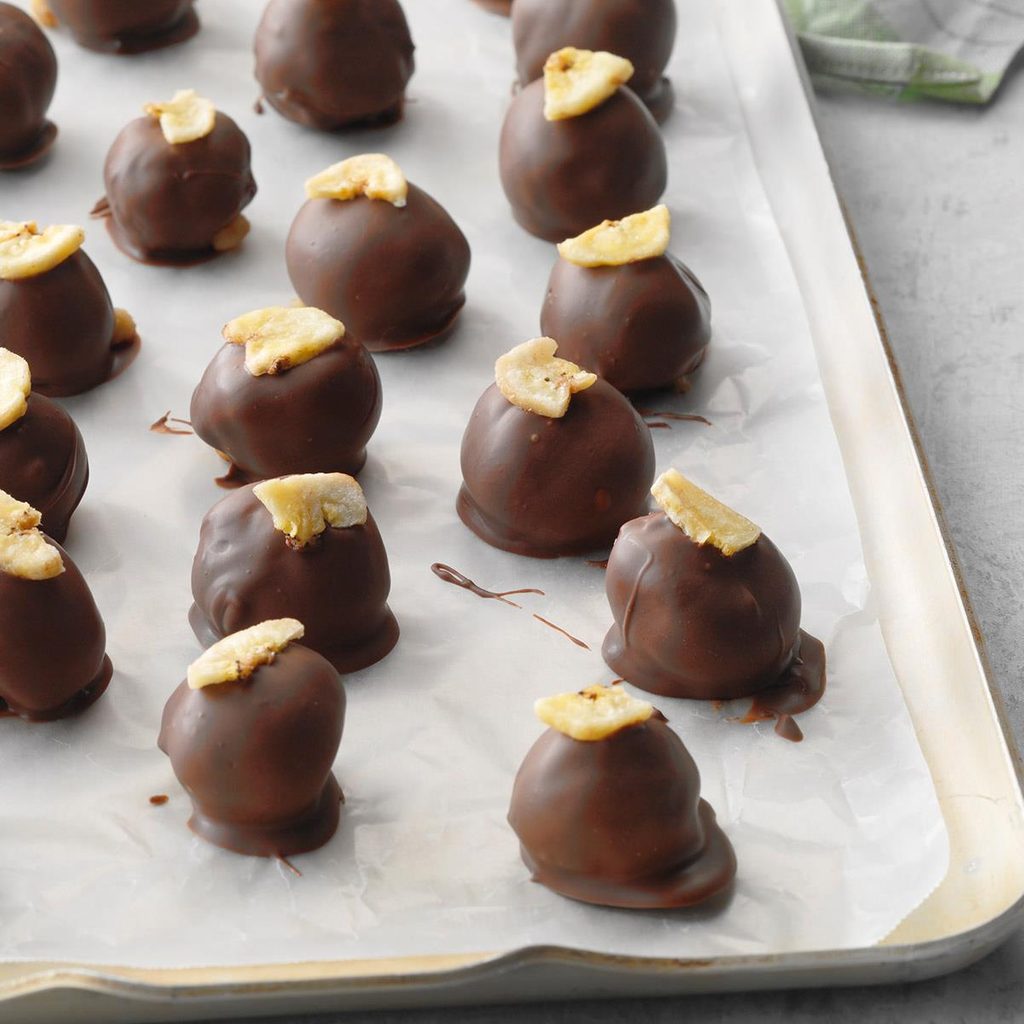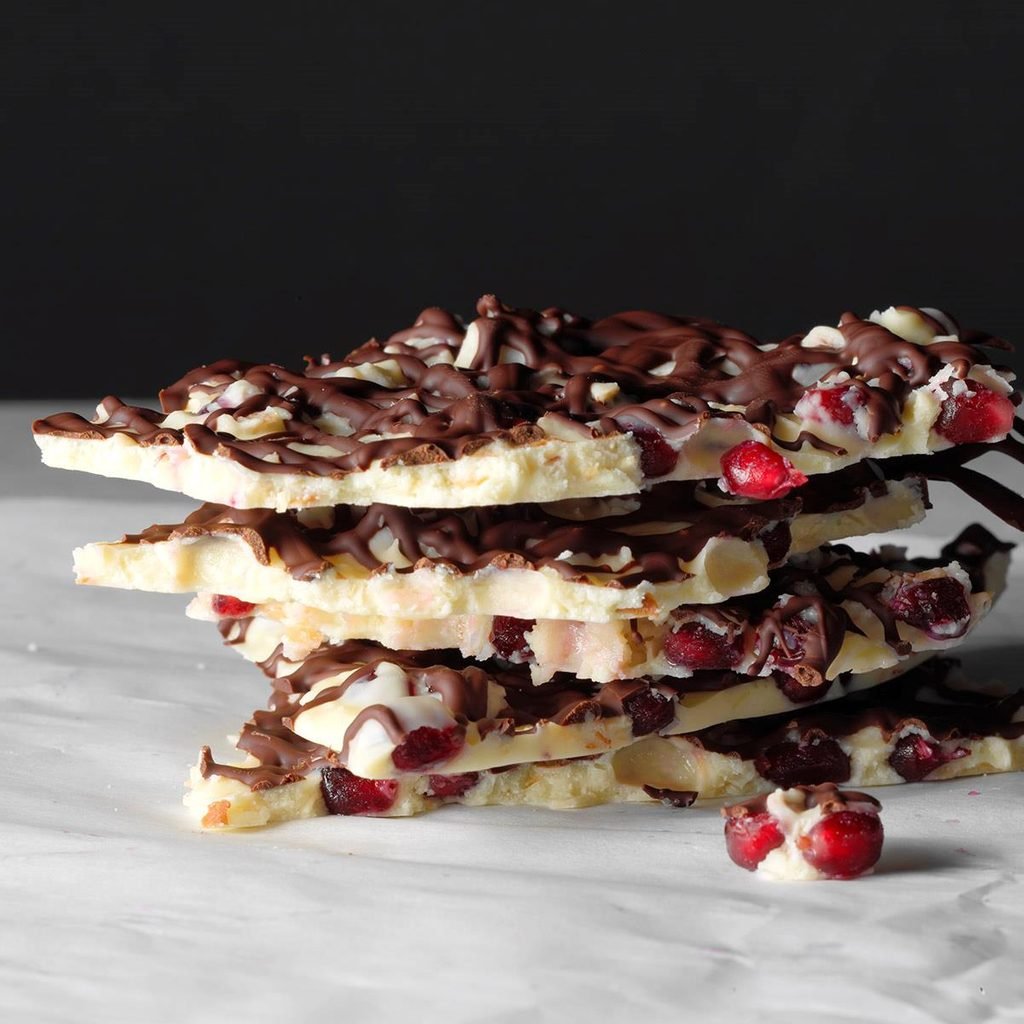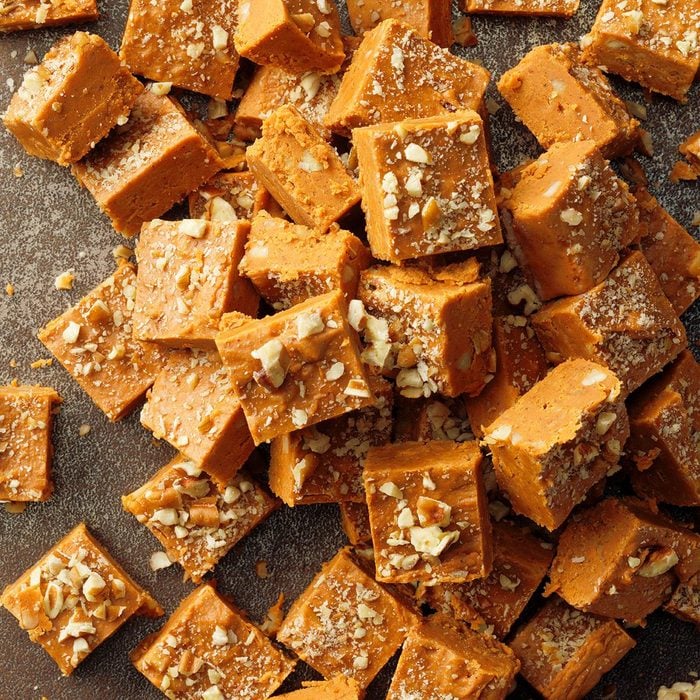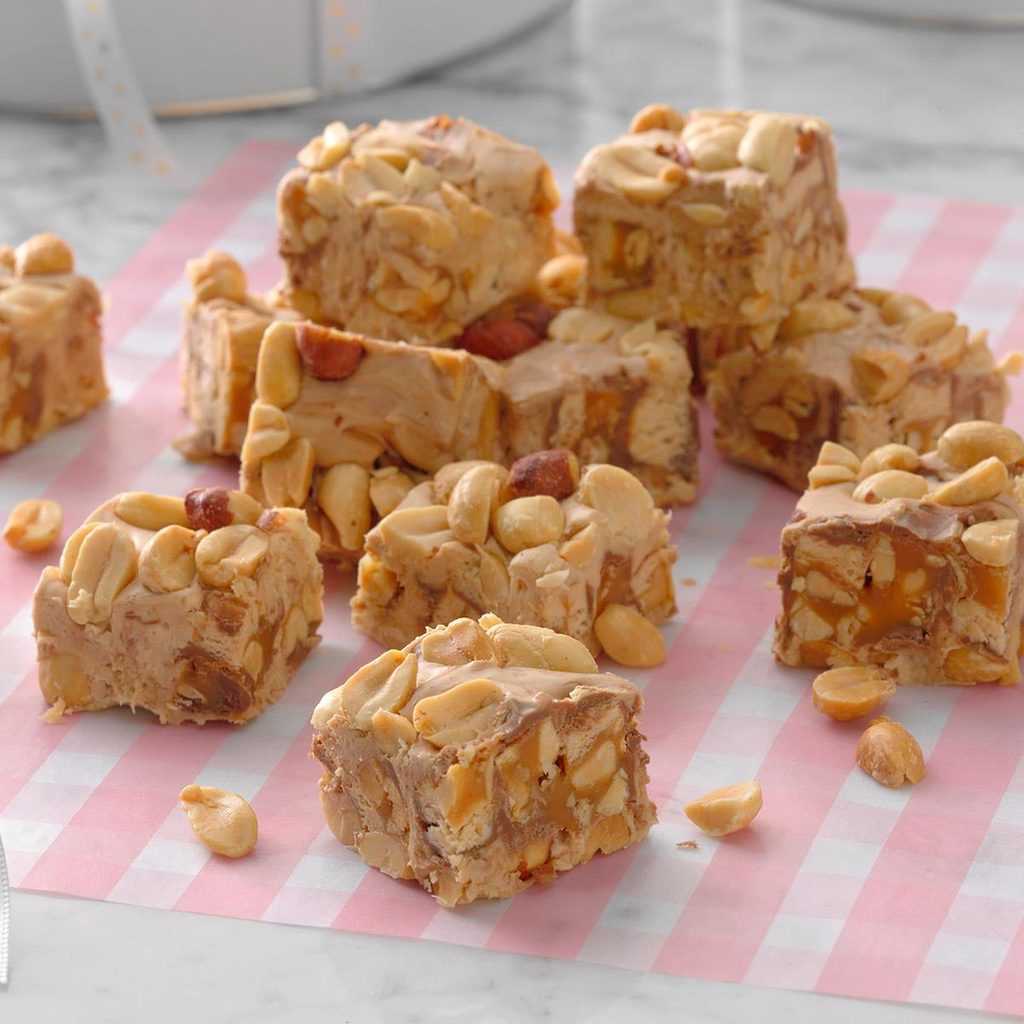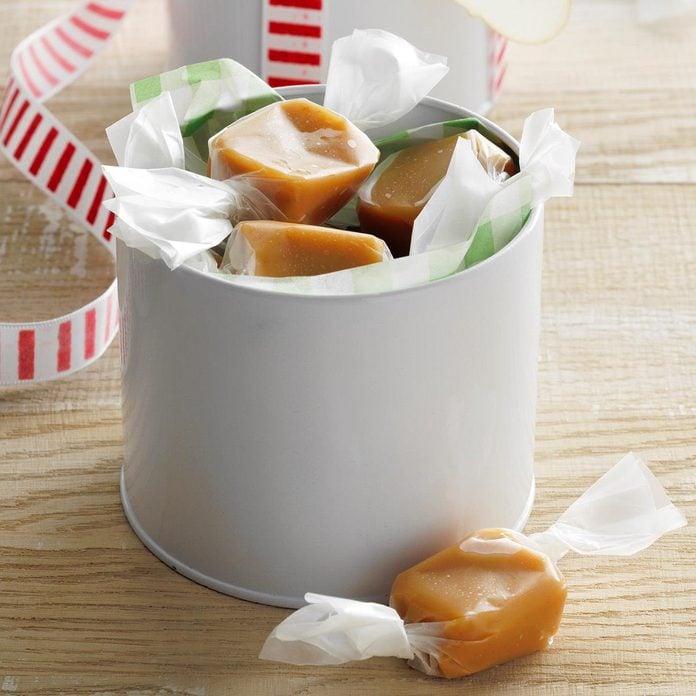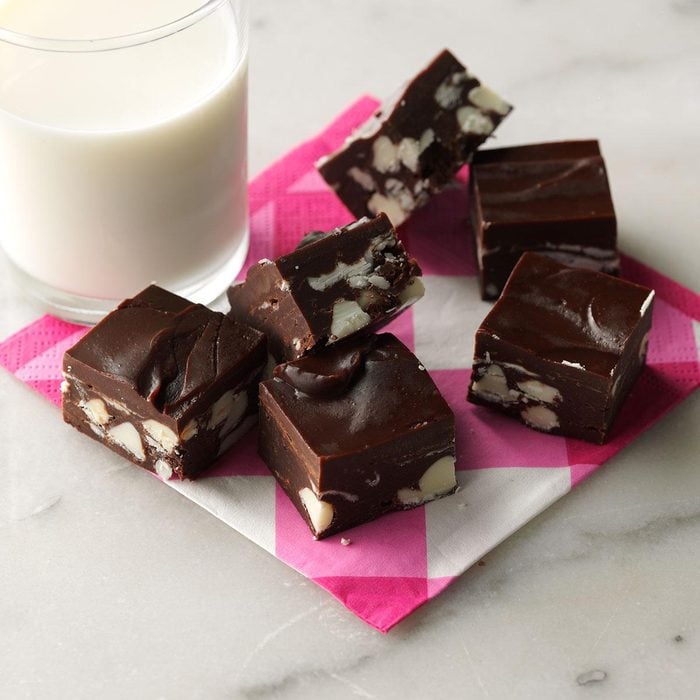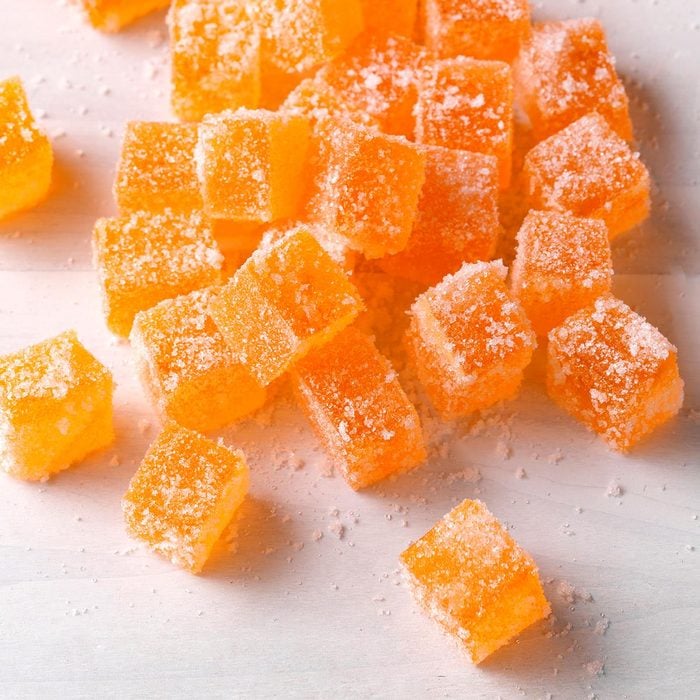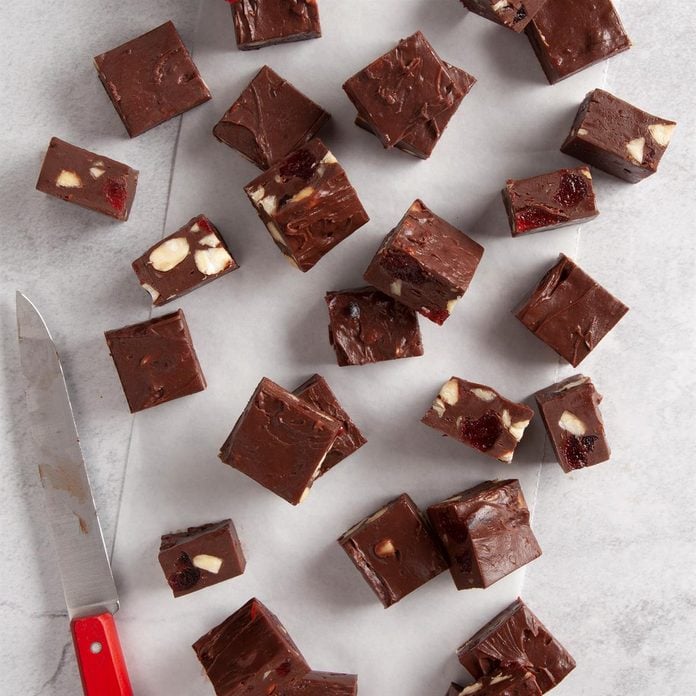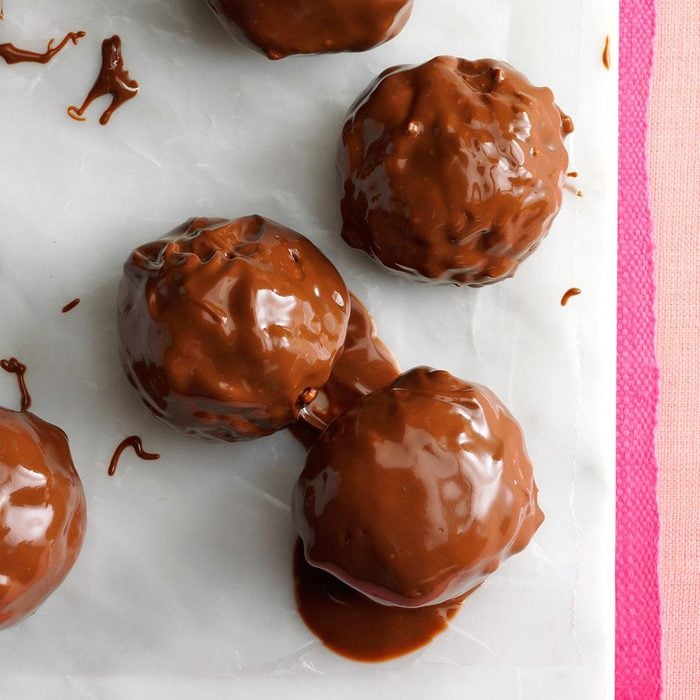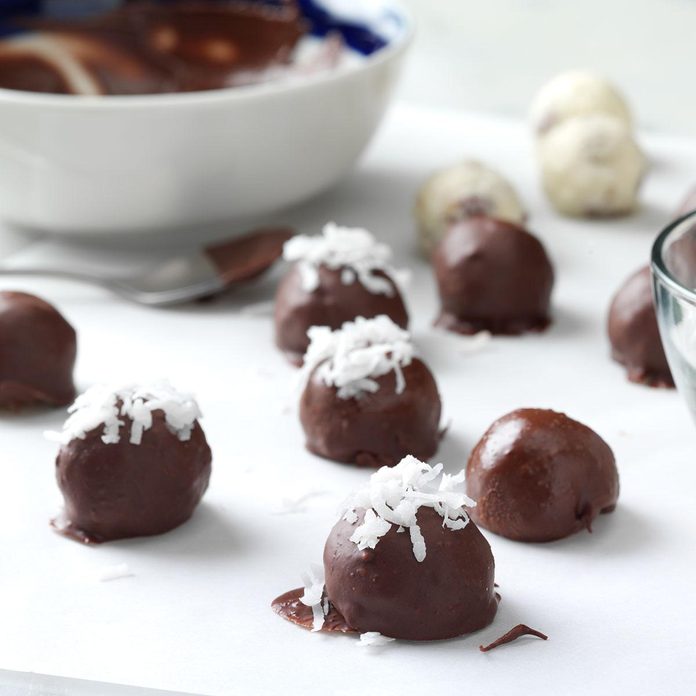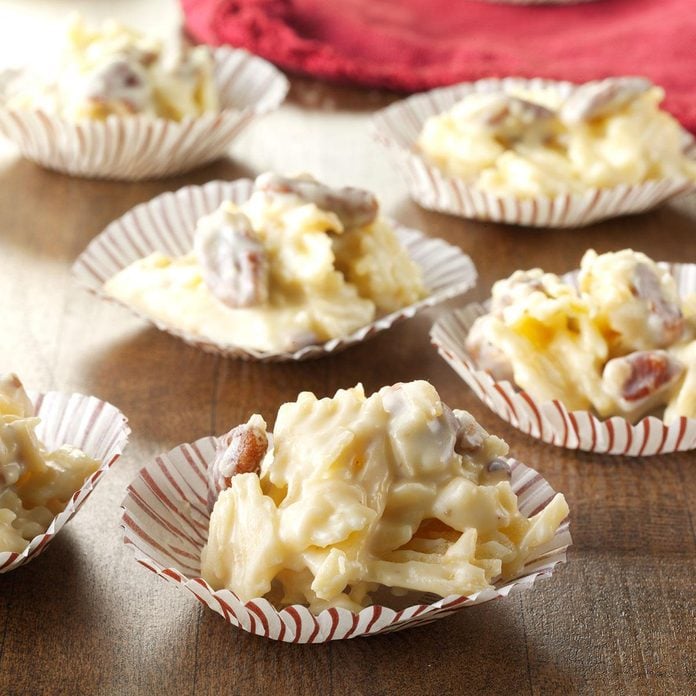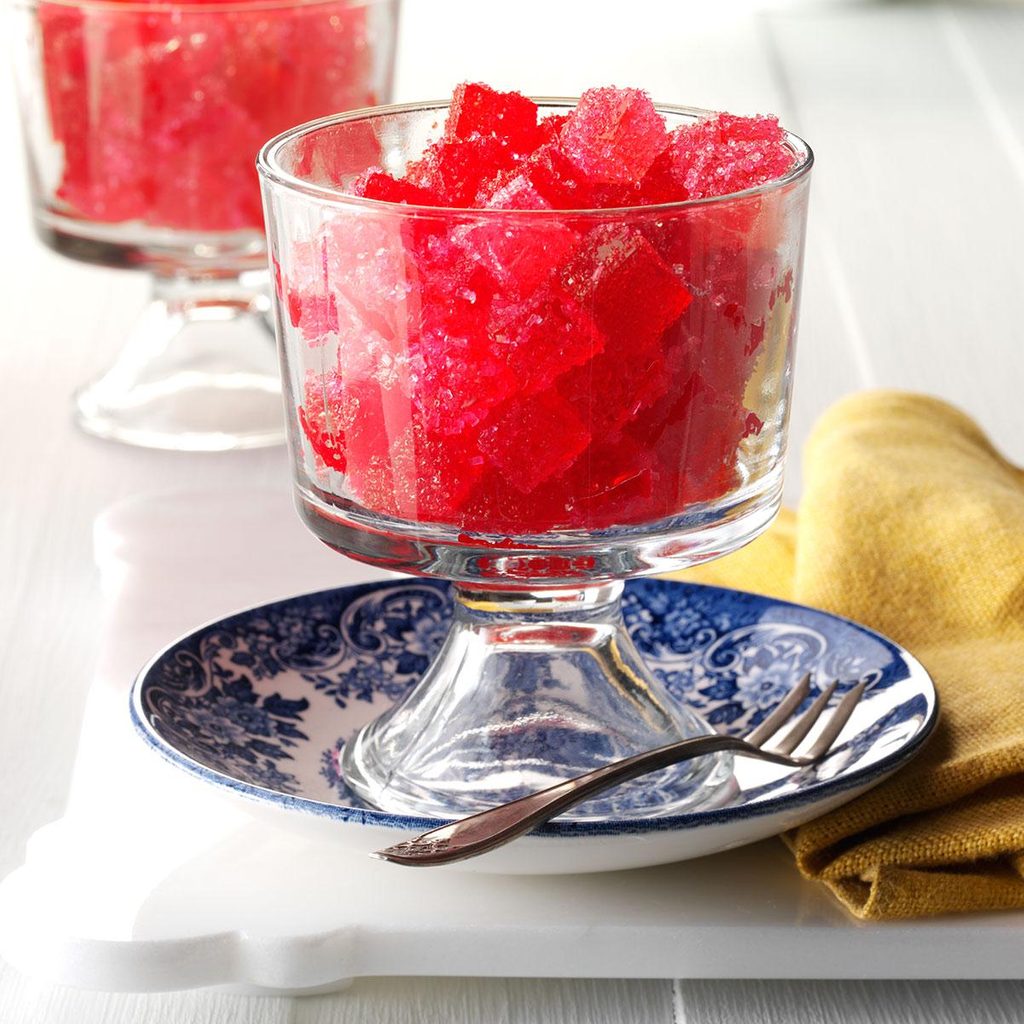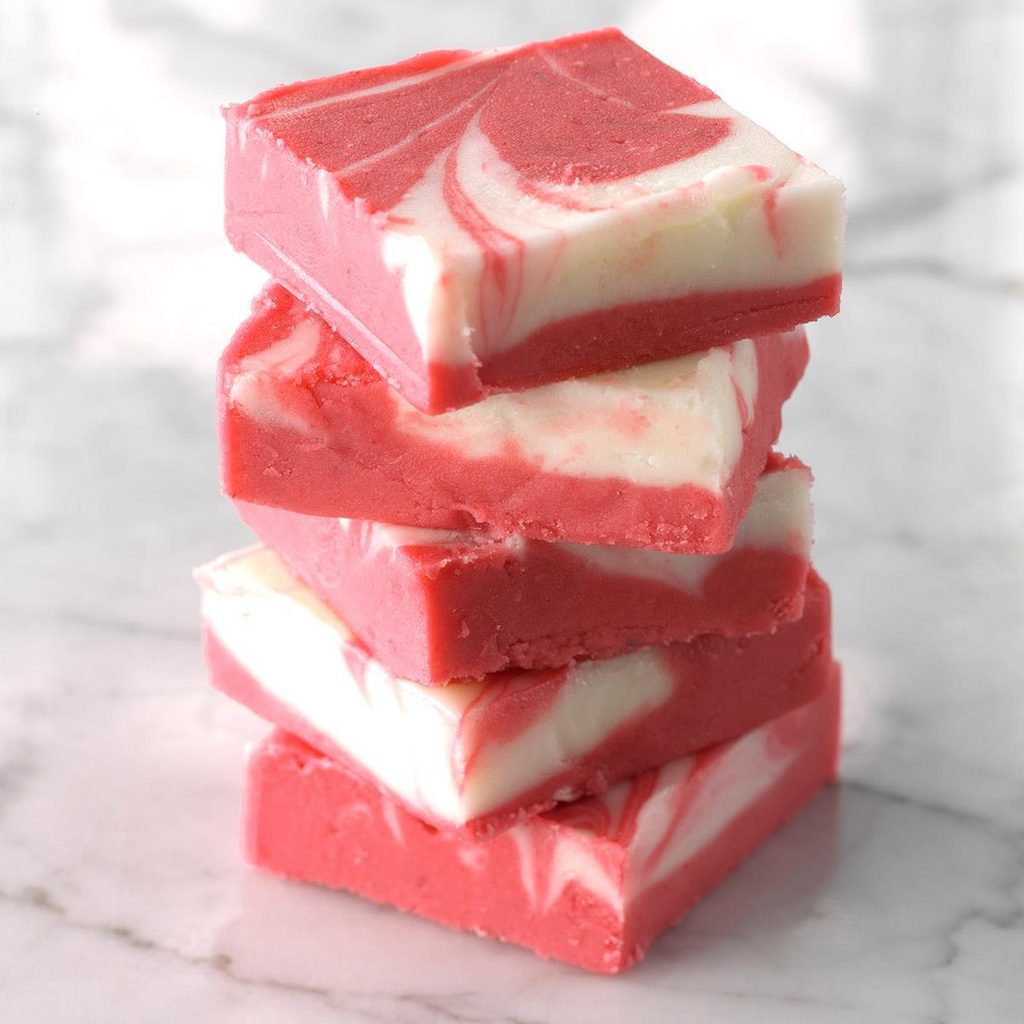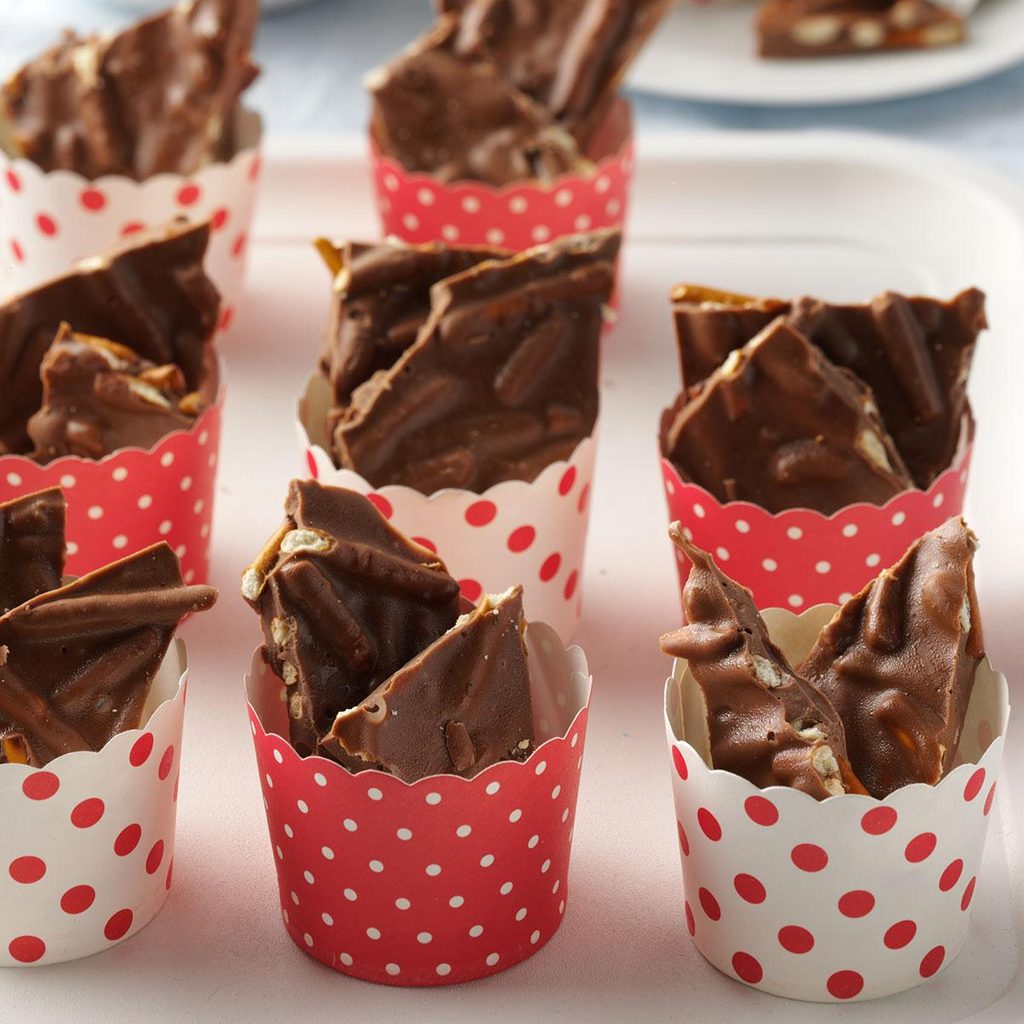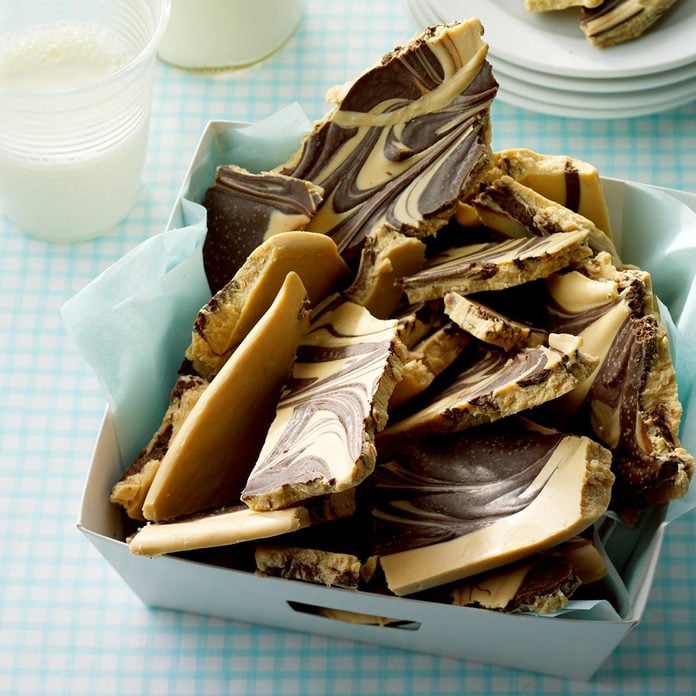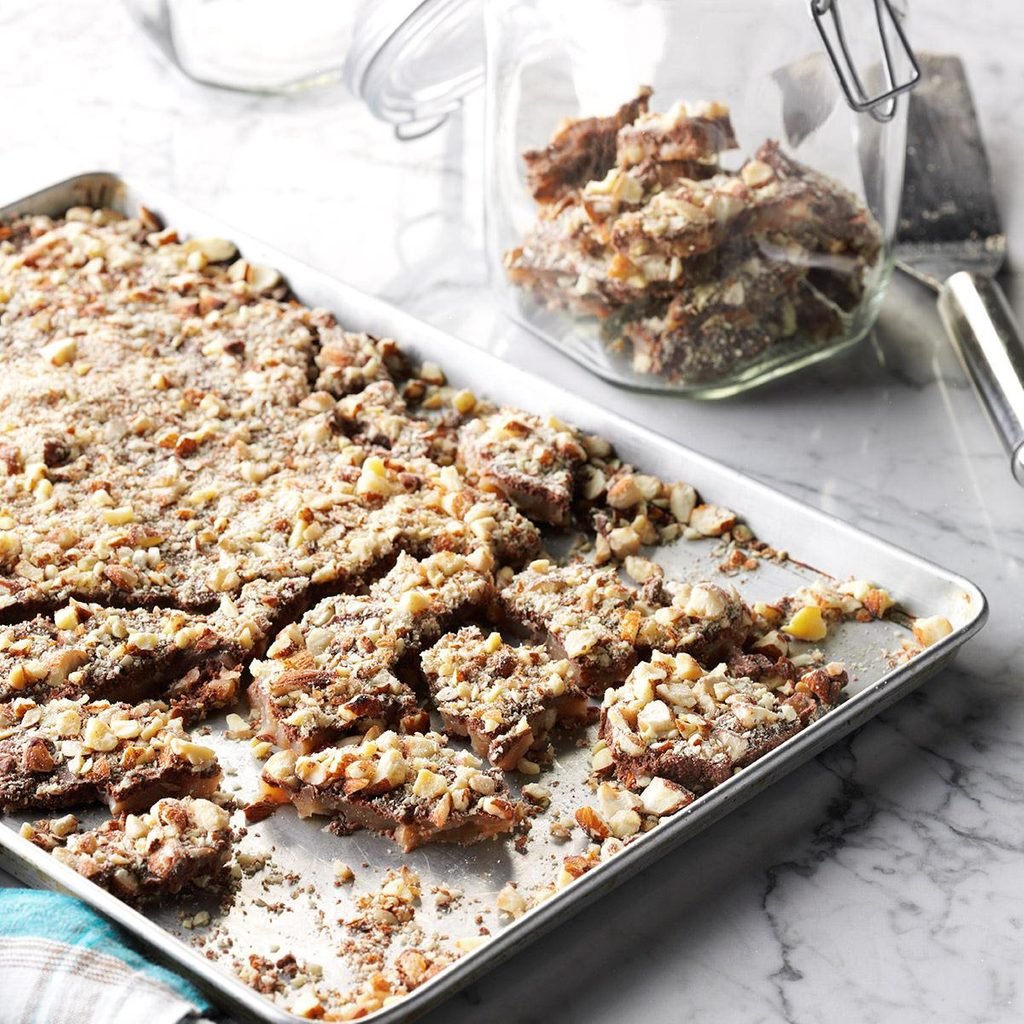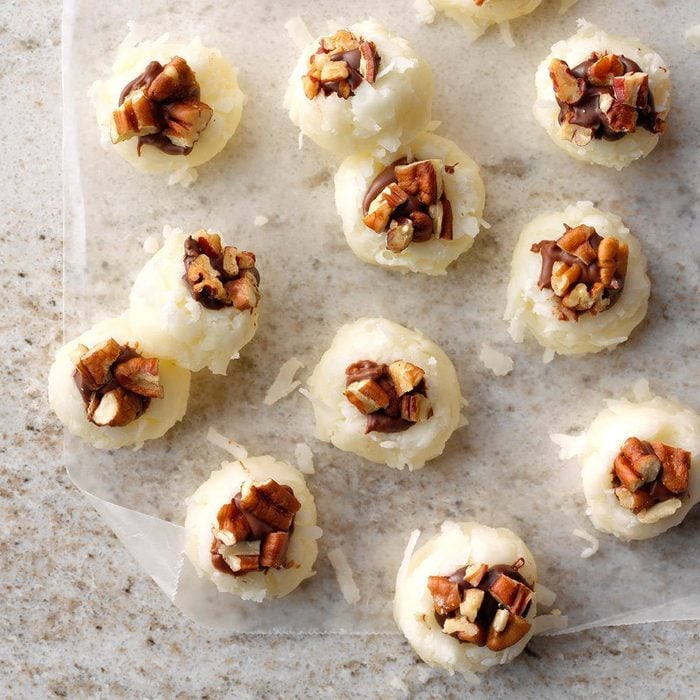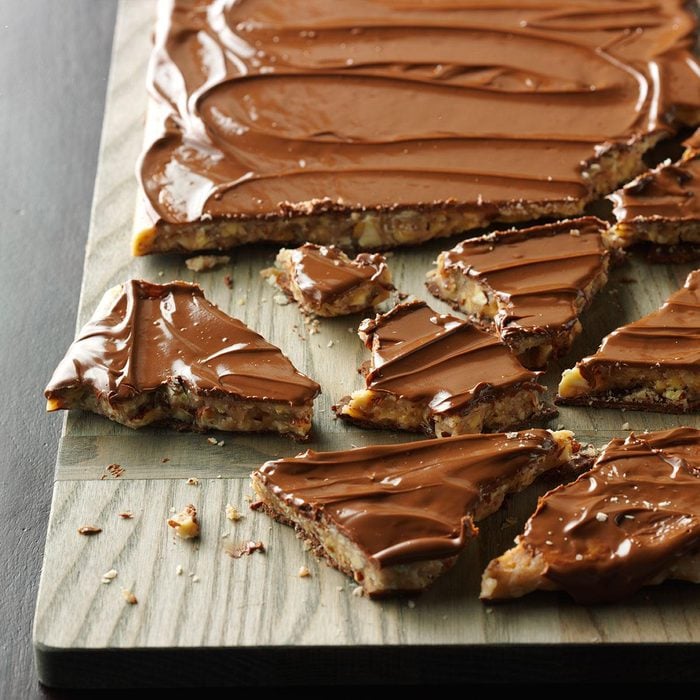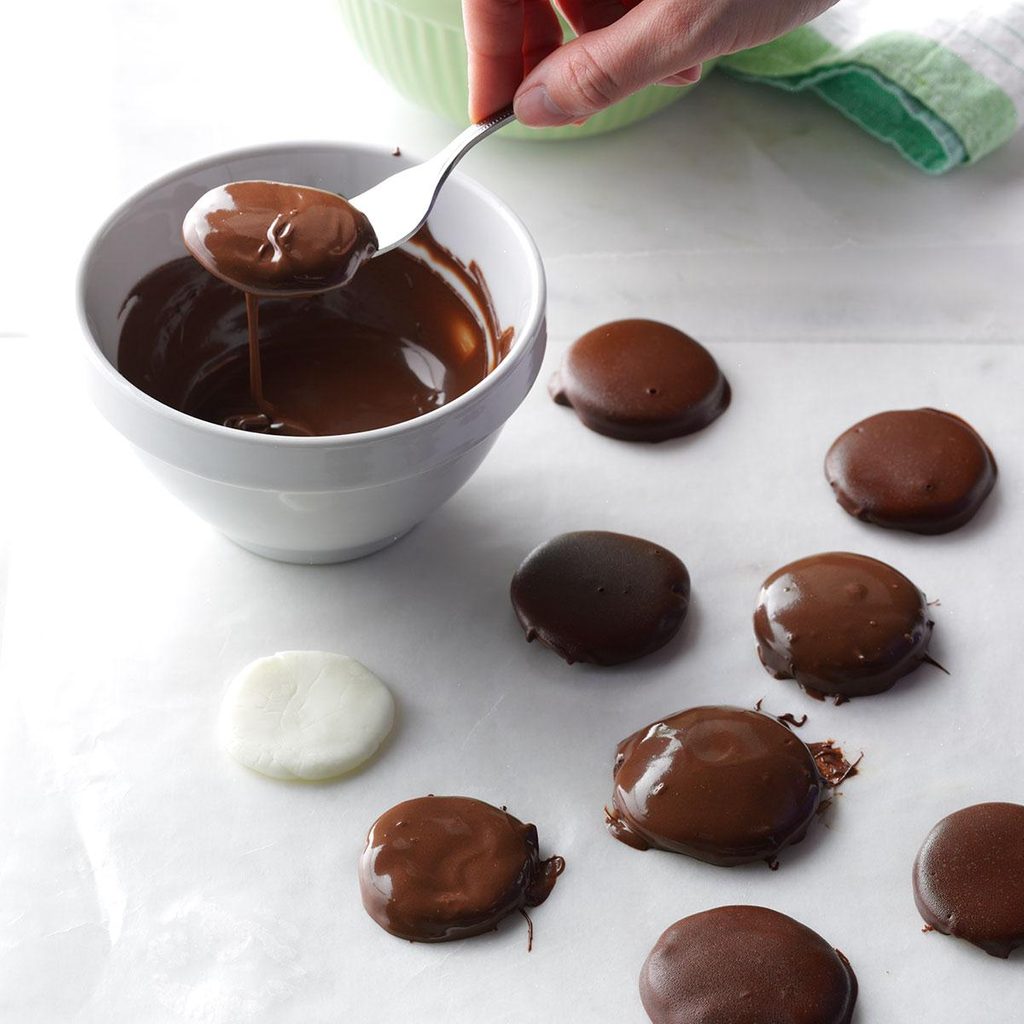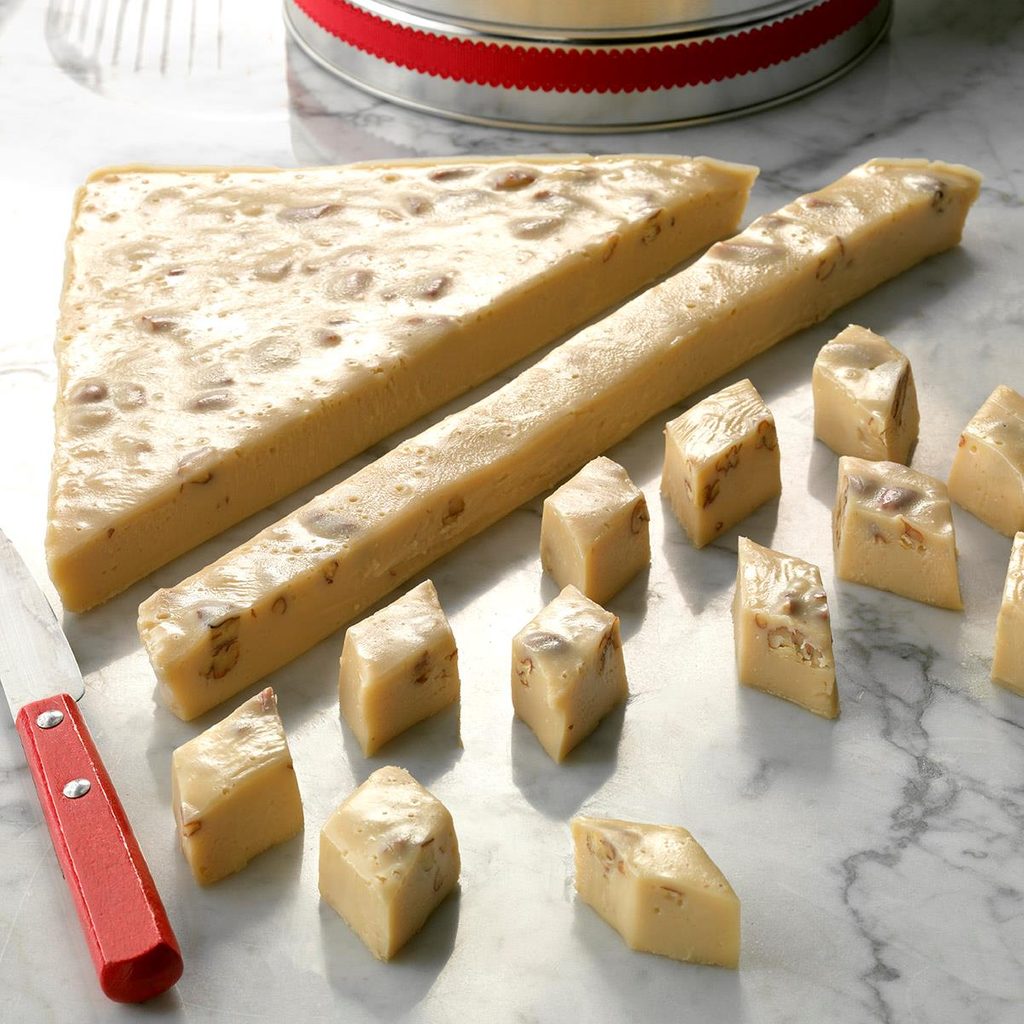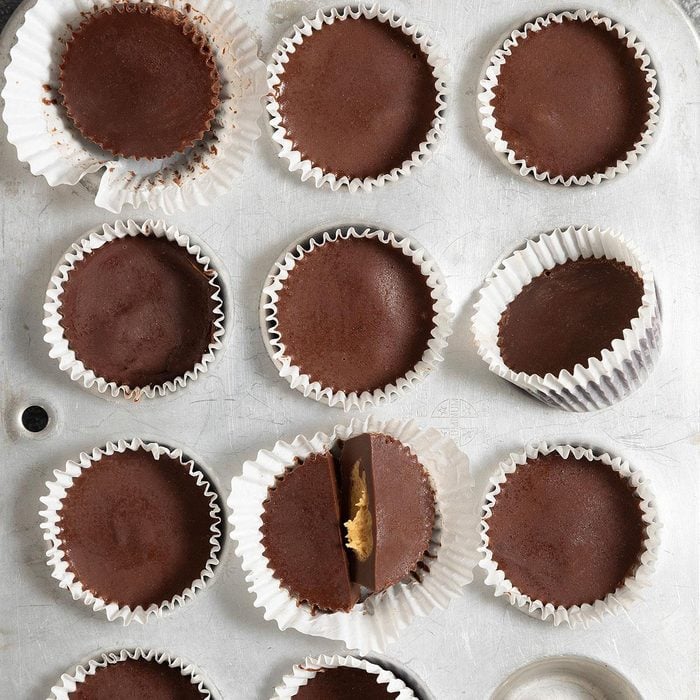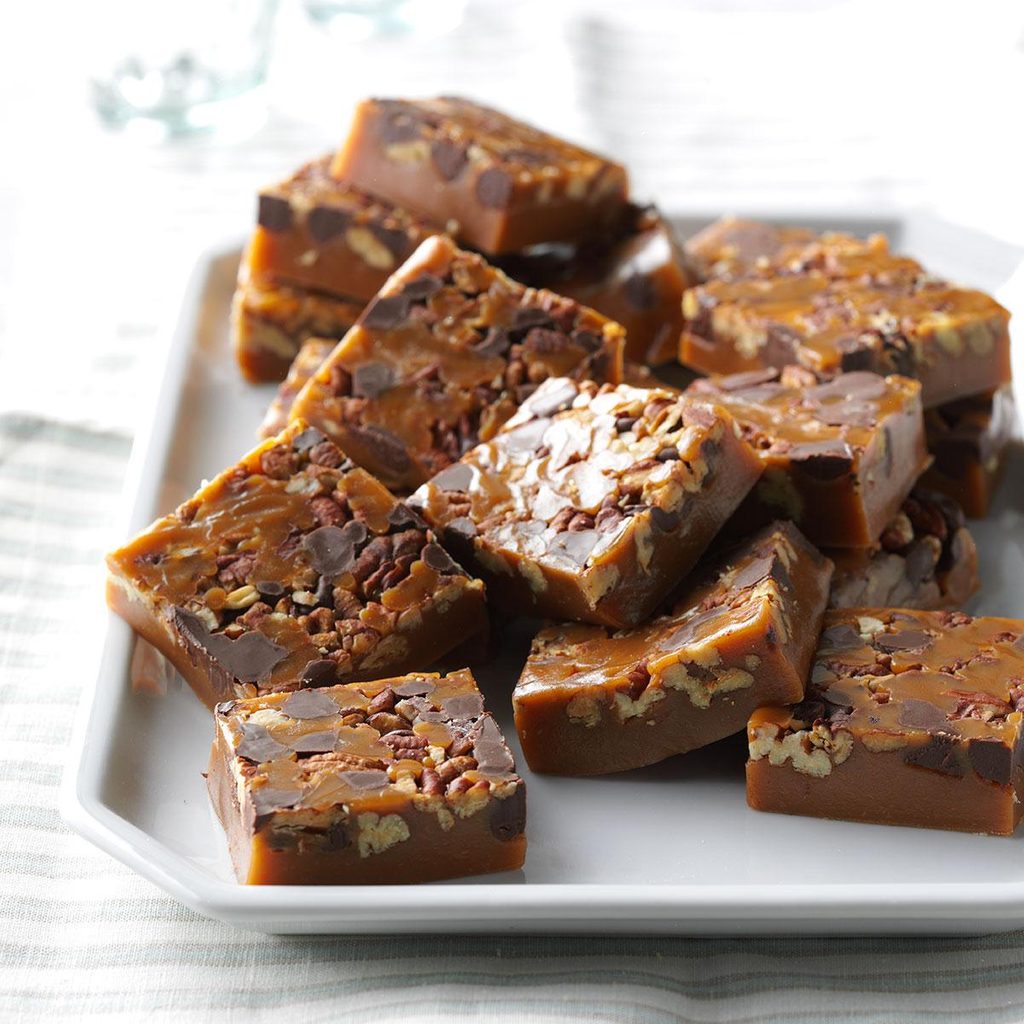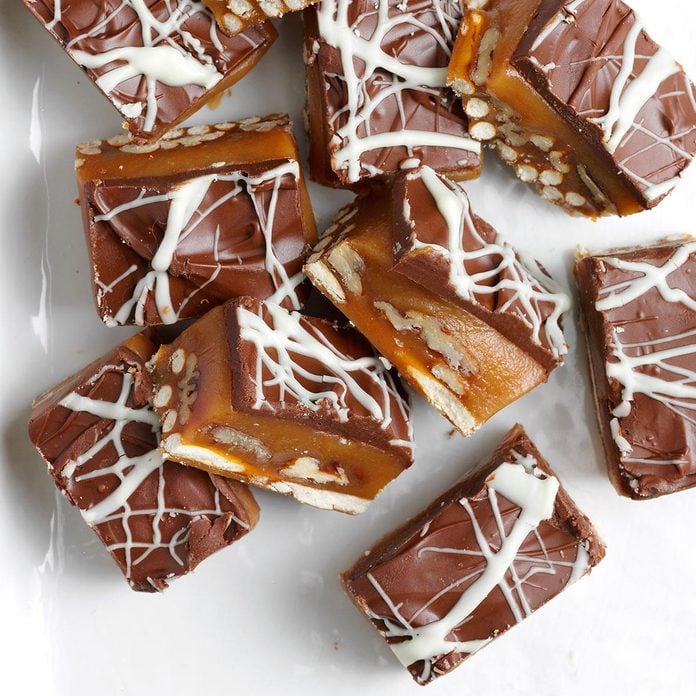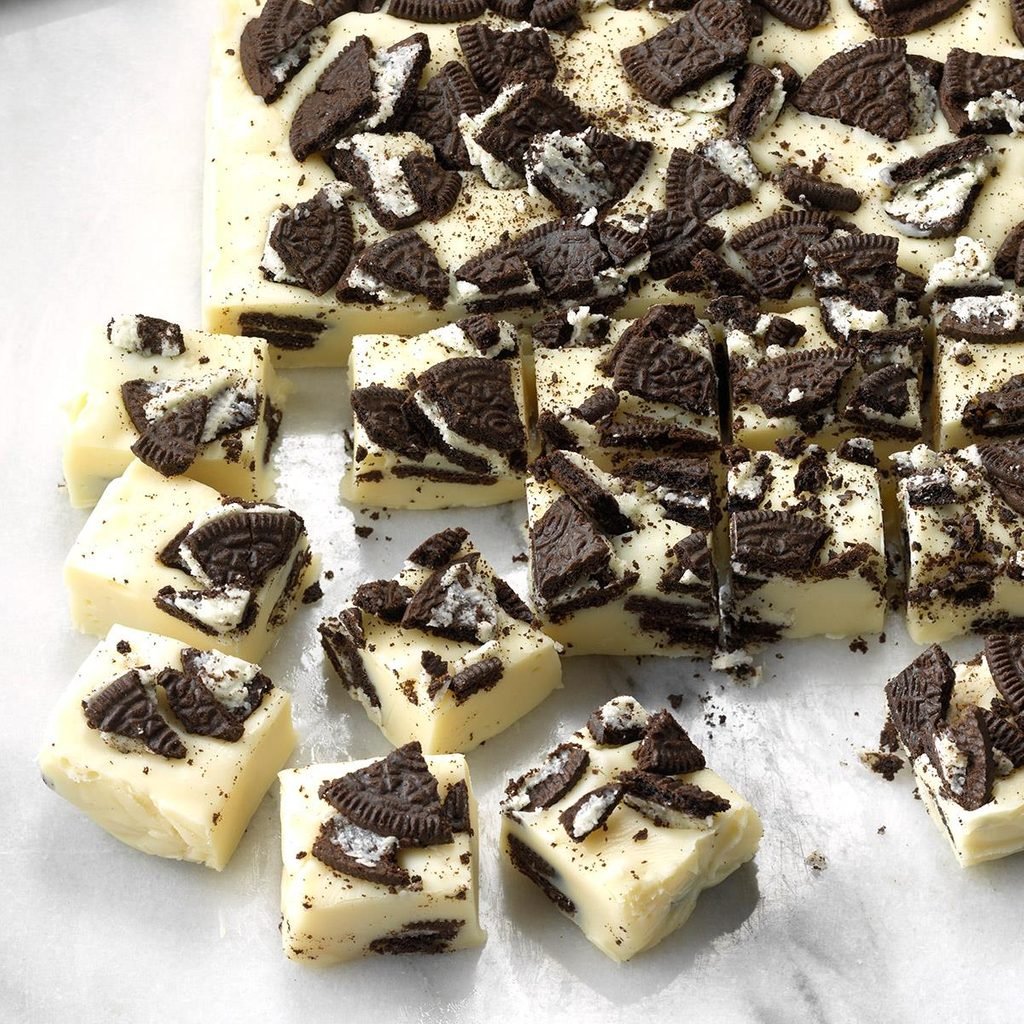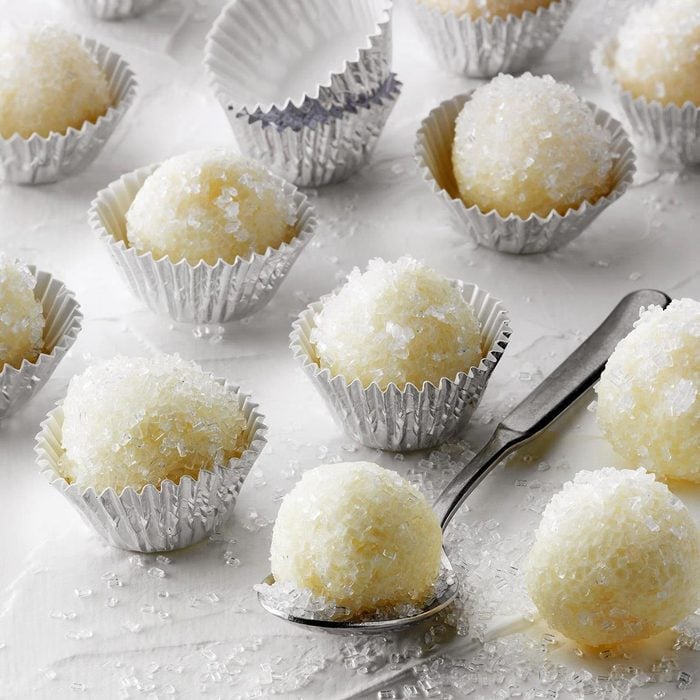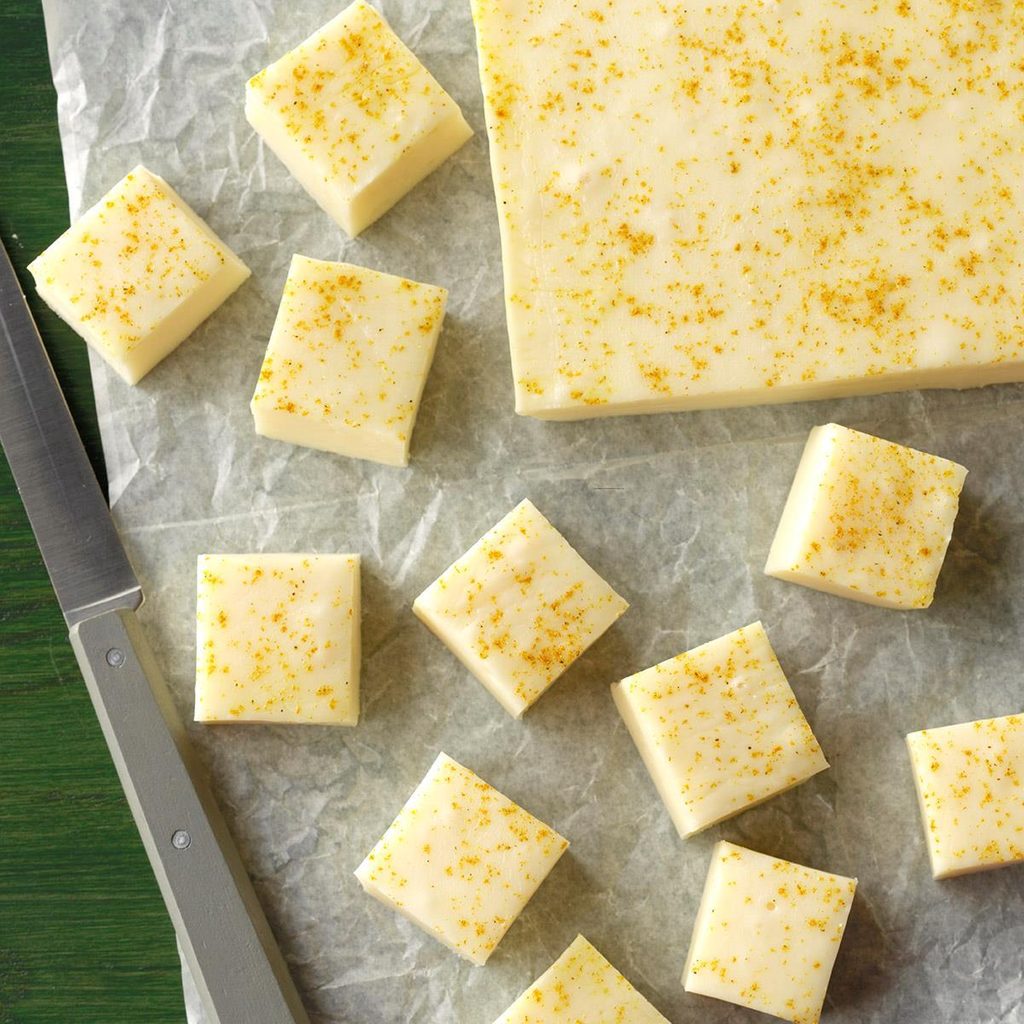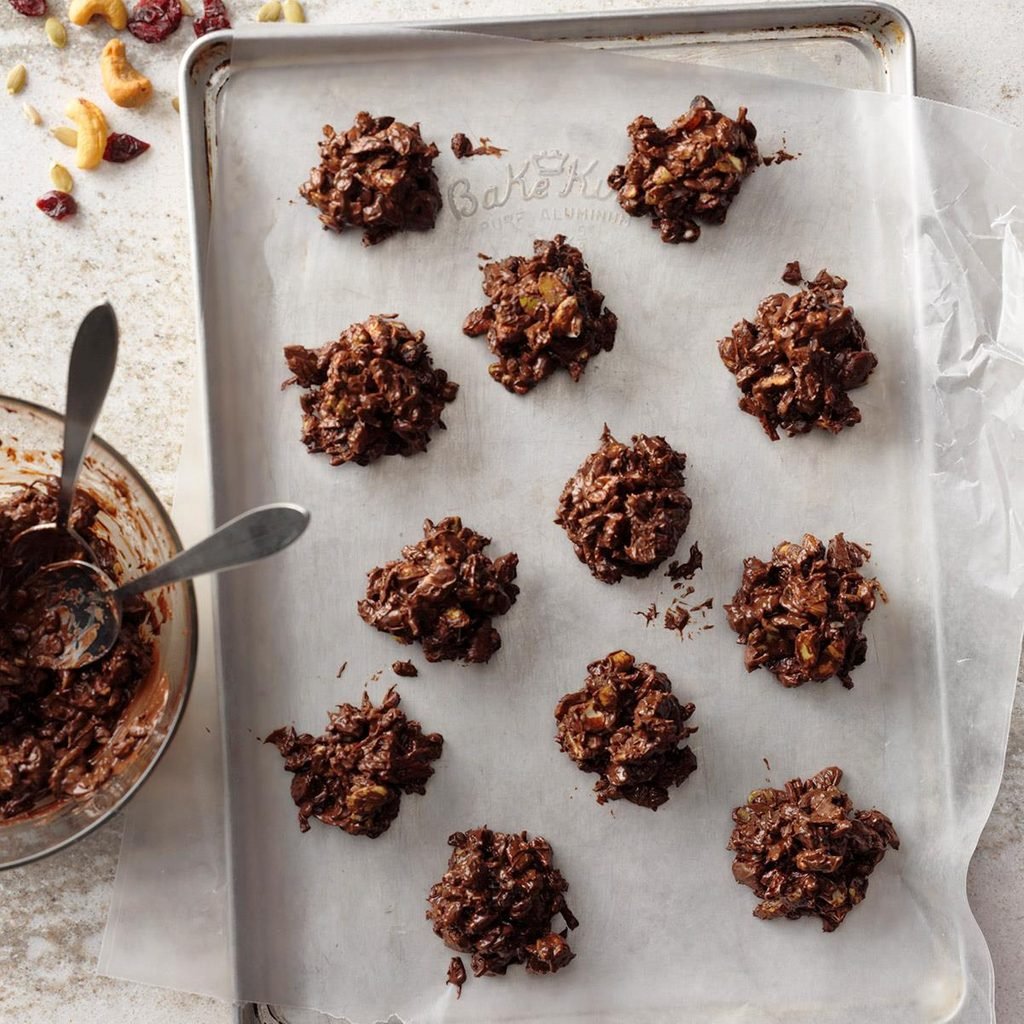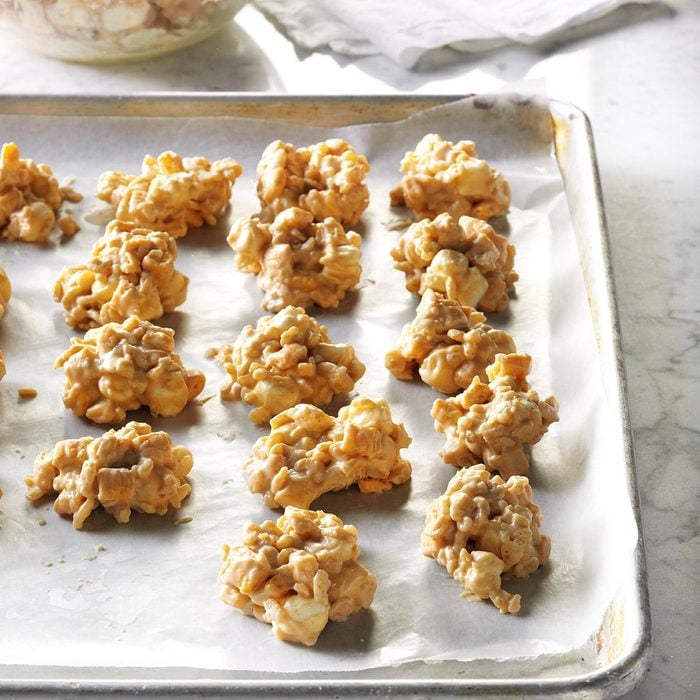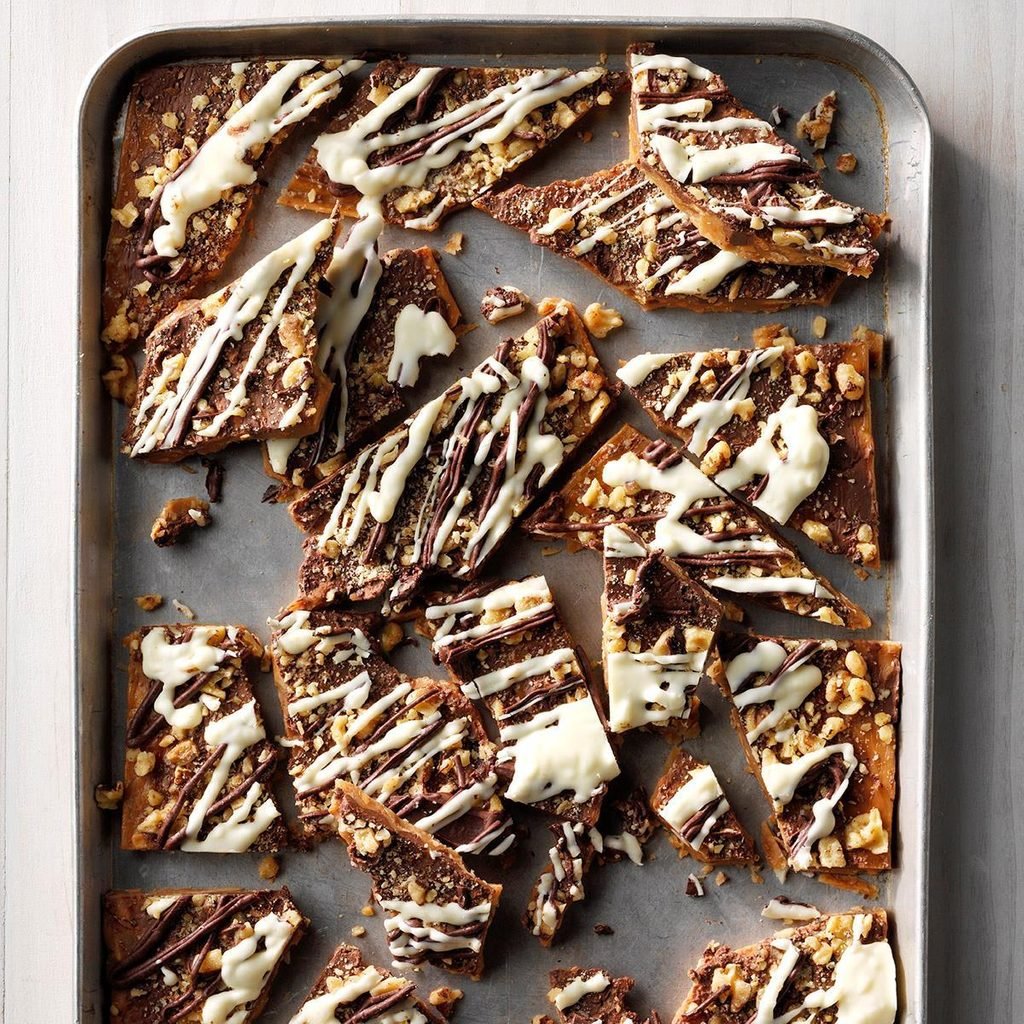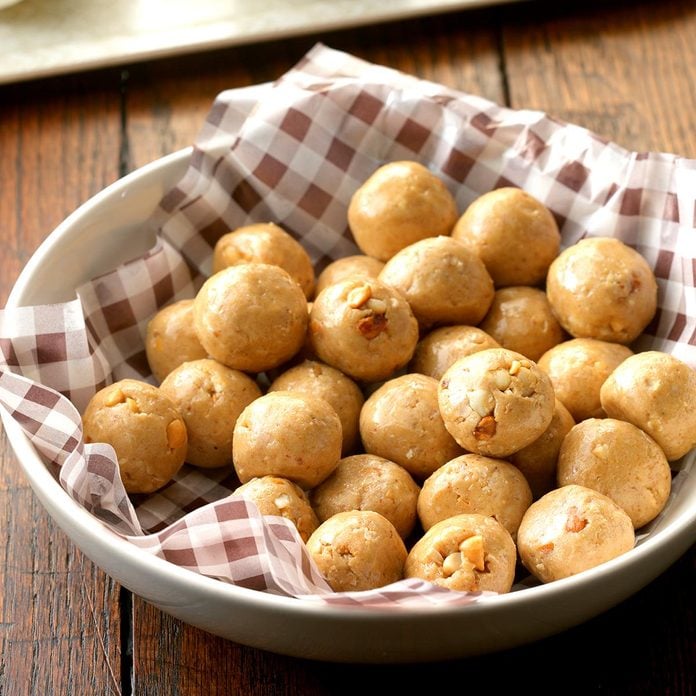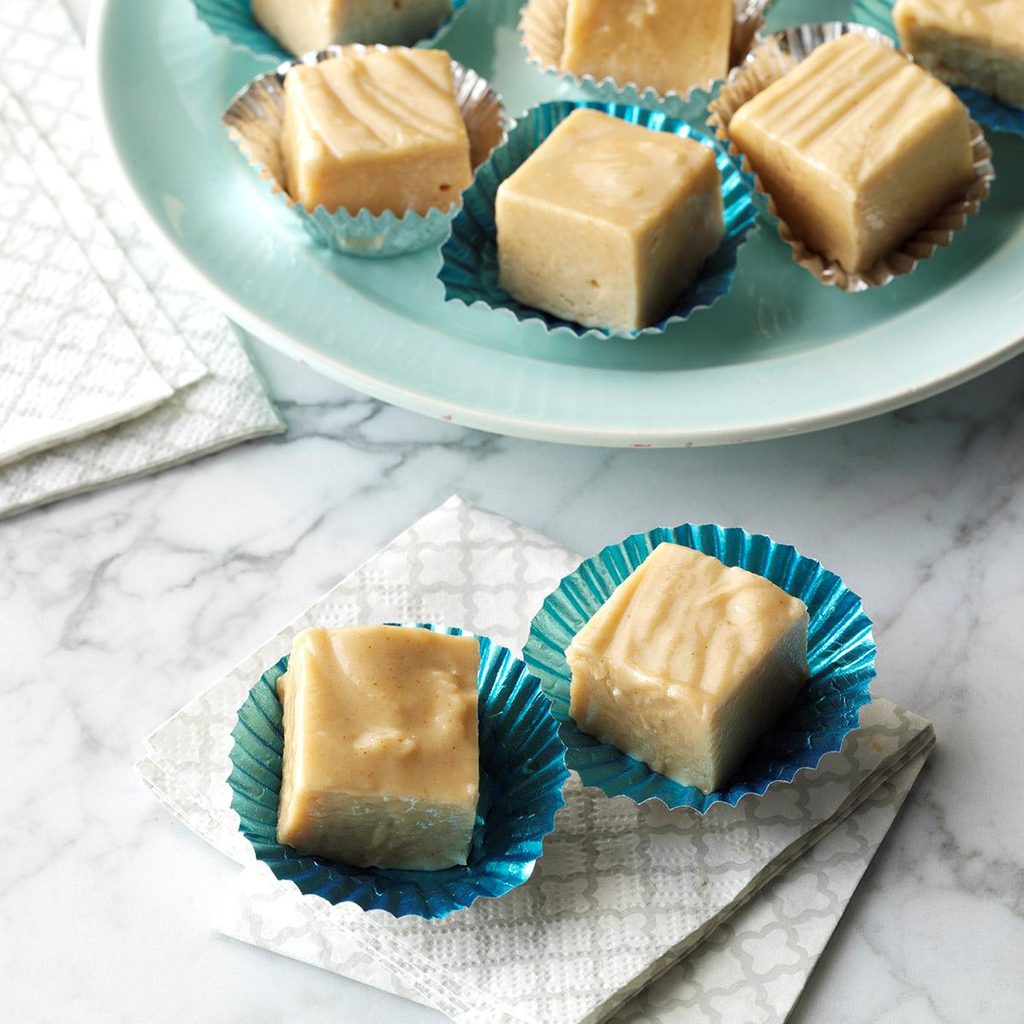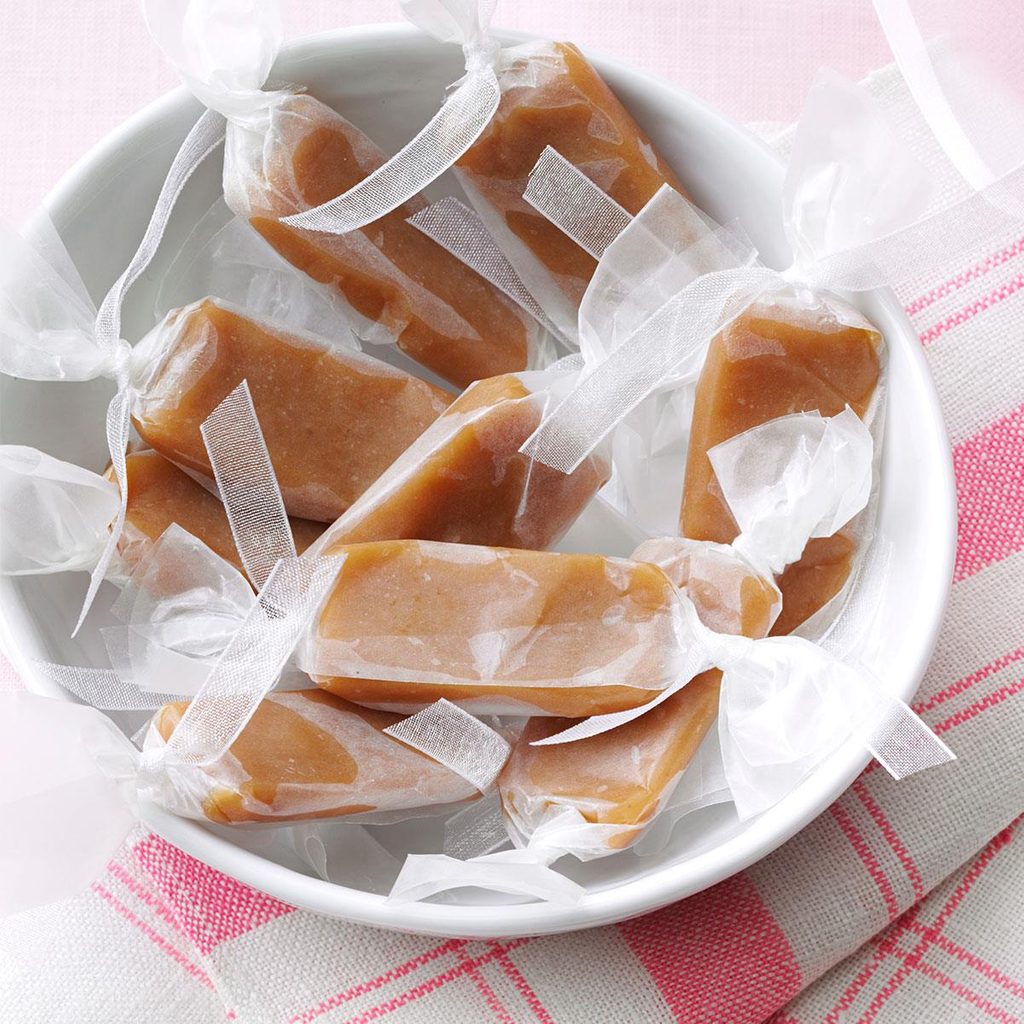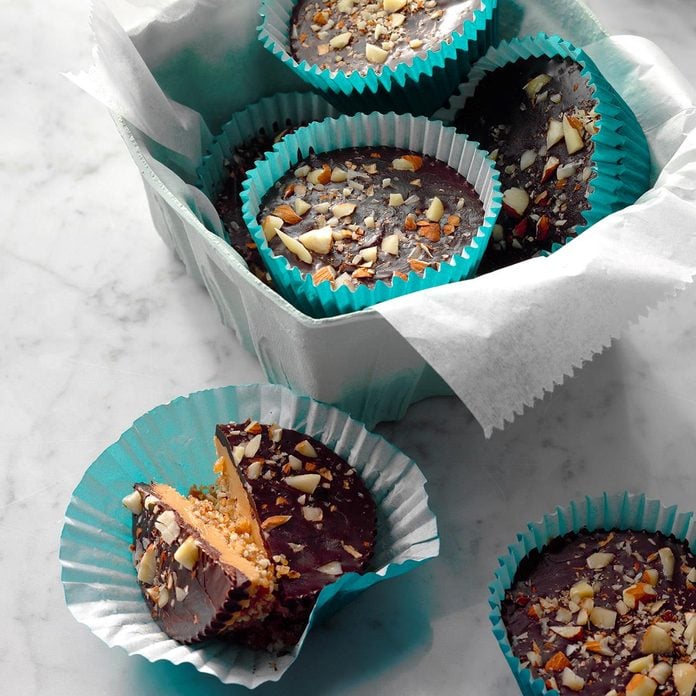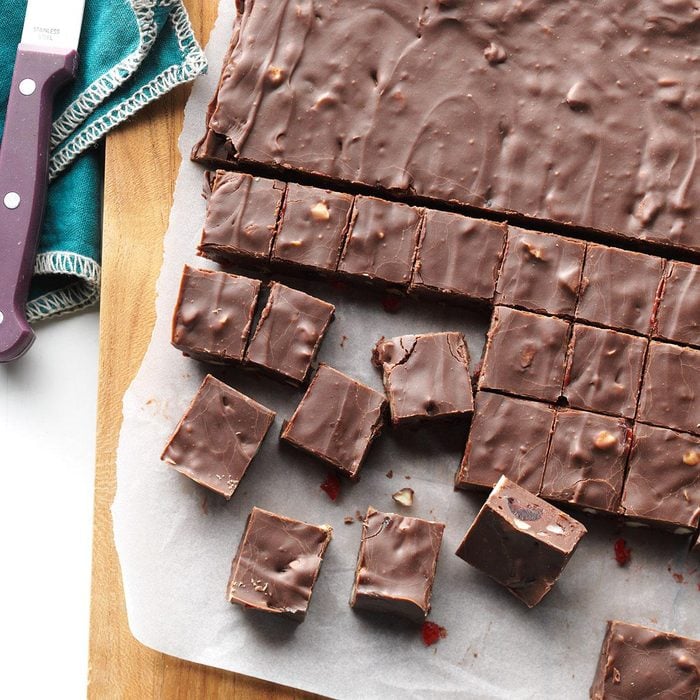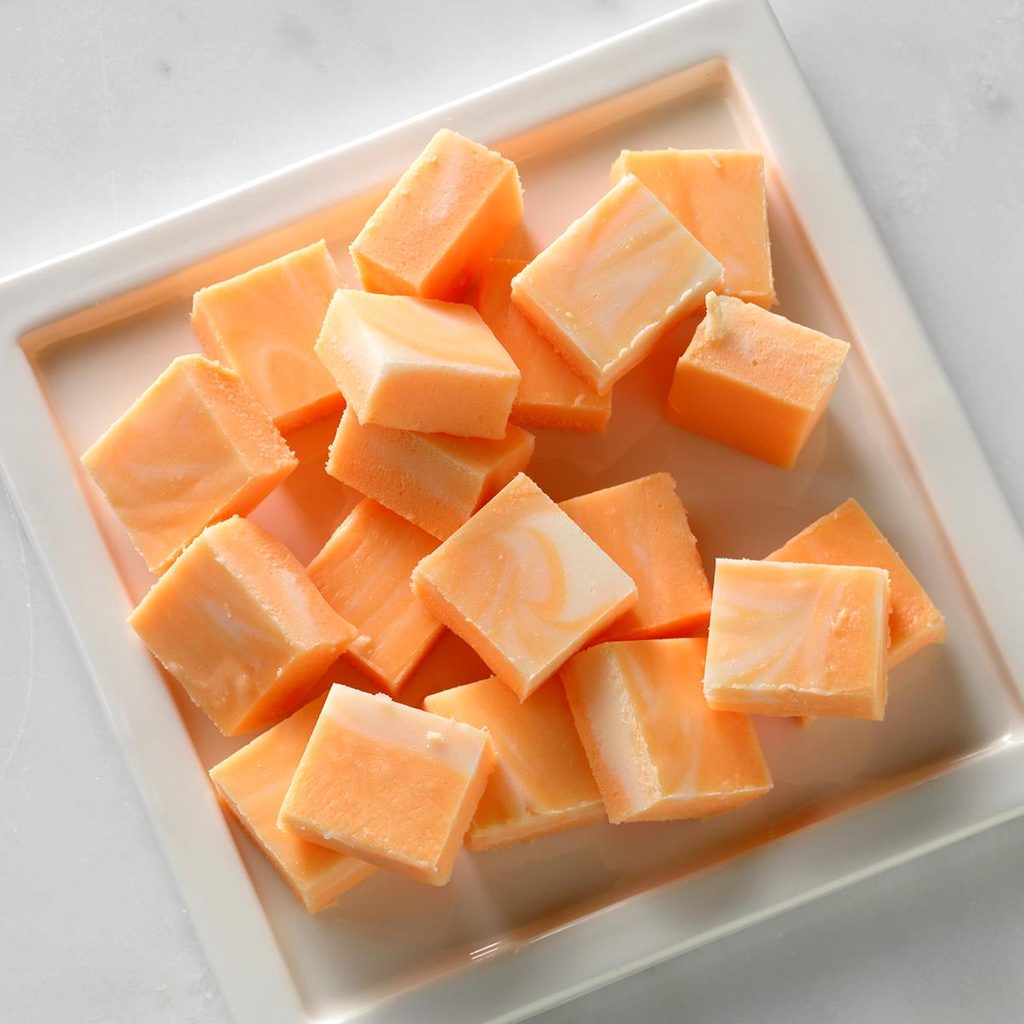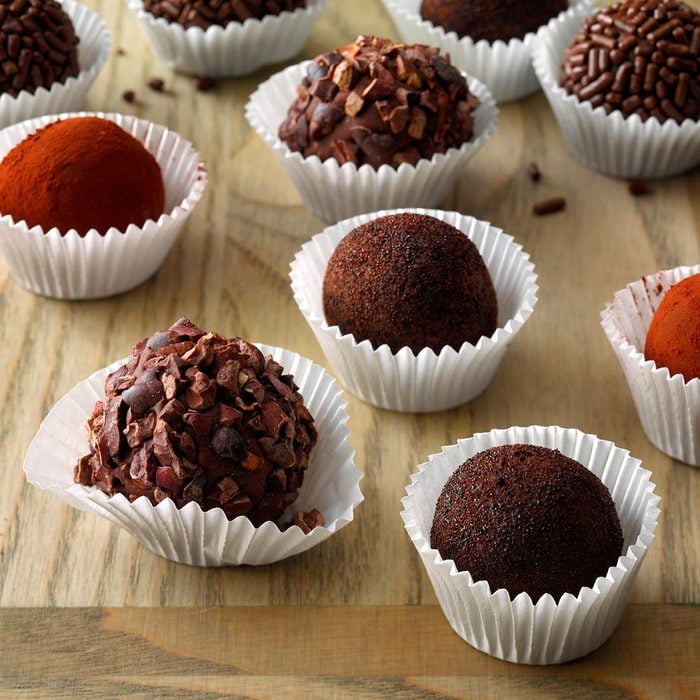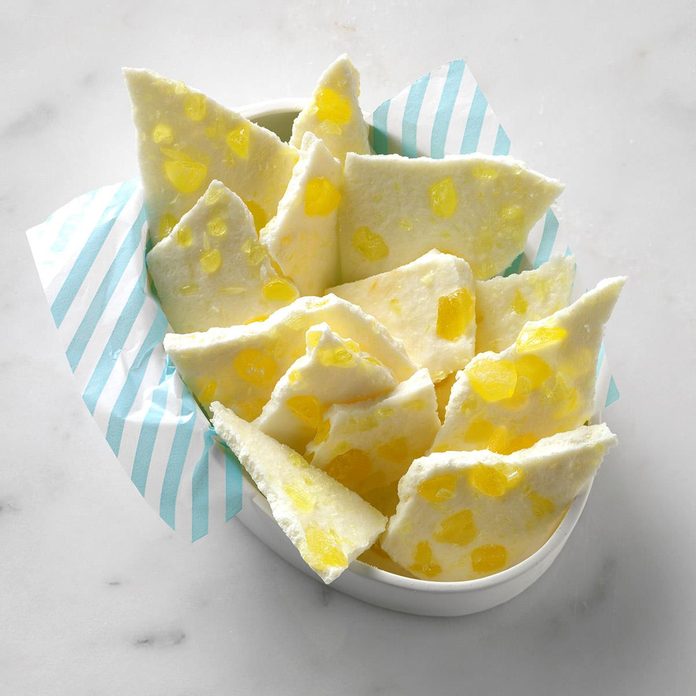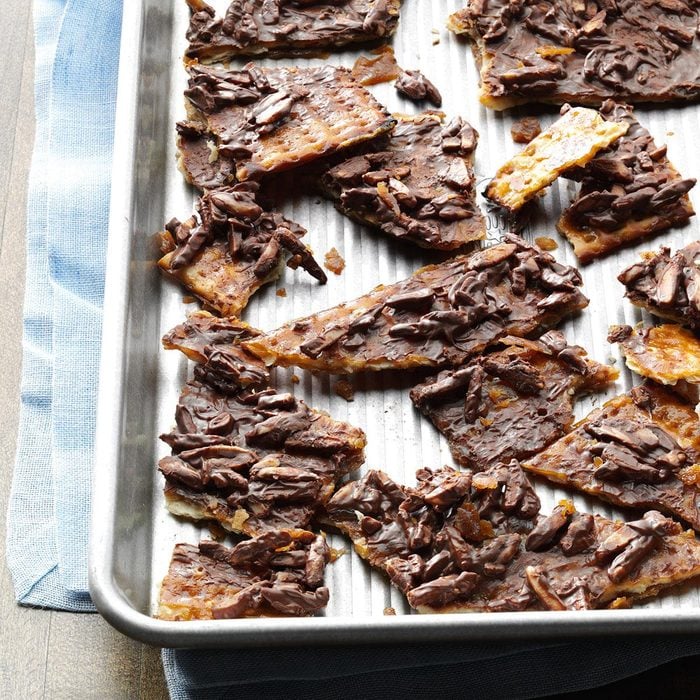 via disneyplus.com, Lauren Habermehl for taste of home
via disneyplus.com, Lauren Habermehl for taste of home
For many, The Lion, the Witch and the Wardrobe is likely the only exposure they’ve had to the sweet confection known as a Turkish Delight. As a child, you may have thought the candy came straight from the imagination of C.S. Lewis.
However, this Turkish confection is very real. And best yet: You can make it right in your kitchen like these other homemade candies.
Now, let’s travel to Narnia (AKA your kitchen) to learn how to make these treats. And if you need to make a detour to check out these 12 recipes inspired by classic novels, that’s OK with us!
What is a Turkish Delight?
A Turkish delight, also known as lokum (pronounced low-COOM) is a confectionary treat that originated in the Ottoman Empire (modern-day Turkey) in the 18th century with early variations dating back to the 15th-century Persian empire.
Today, these sweet little cubes can be found at markets and confectioners in Istanbul and throughout Turkey. You can even buy them on Amazon.
Dusted in cornstarch and powdered sugar, the most common flavor for Turkish Delight (as seen in The Lion, the Witch and the Wardrobe) is rose. However, they can also be lemon, orange, pomegranate or even chocolate. Some Turkish Delights also can be filled with nuts or dried fruit (walnuts, hazelnuts, pistachios) or rolled in coconut or finely chopped nuts.
Why Turkish Delights?
Turkish Delights may seem like a rather random request from Edmund to the White Witch. However, given the time period that C.S. Lewis grew up in, it’s not surprising that this enchanting treat worked its way into the pages of The Lion, the Witch and the Wardrobe, which was published in 1950.
C.S. Lewis grew up in Late Victorian England when imports of this special Turkish treat began appearing on shelves in London (along with Victorian fruitcake).
It is believed that this sweet indulgence, likely held a special nostalgia for C.S. Lewis and was something he sorely missed while writing the Chronicles of Narnia. The Chronicles were written in post-wartime Europe where sugar and sweets were difficult to obtain since they continued to be rationed through 1953. (Don’t miss these other vintage World War II recipes.)
How to Make Turkish Delight
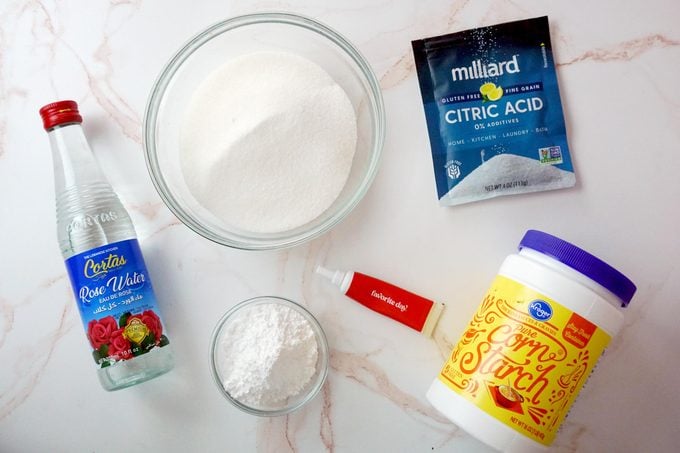 Lauren Habermehl for taste of home
Lauren Habermehl for taste of home
As wisely stated by Aslan the lion, “All shall be done, but it may be harder than you think.”
Turkish delights are not quick or easy to make. Follow the directions carefully, have patience, and, in time, you’ll be rewarded.
This recipe makes 36 (1-inch) cubes.
Ingredients
- 2 cups white sugar
- 2-3/4 cups water, divided
- 1/4 teaspoon citric acid
- 1/2 cup cornstarch
- 1 teaspoon rose water
- 1/8 teaspoon of gel red food color
For Coating
- 1/2 cup cornstarch
- 1/2 cup powdered sugar
Directions
Step 1: Combine
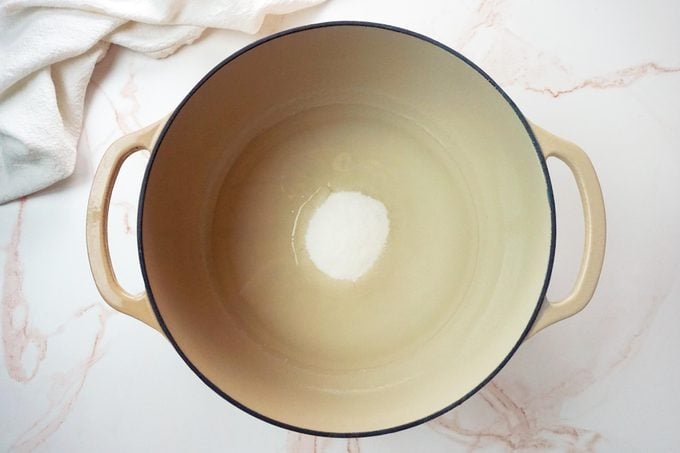 Lauren Habermehl for taste of home
Lauren Habermehl for taste of home
In a heavy-bottomed pot or Dutch oven, whisk together the sugar, citric acid and 3/4 cup of water.
Editor’s Tip: We recommend using a Dutch oven with a light-colored interior since it will greatly help in judging the color of the mixture as it cooks. This is important for getting the consistency just right.
Step 2: Heat to Hard Ball Stage
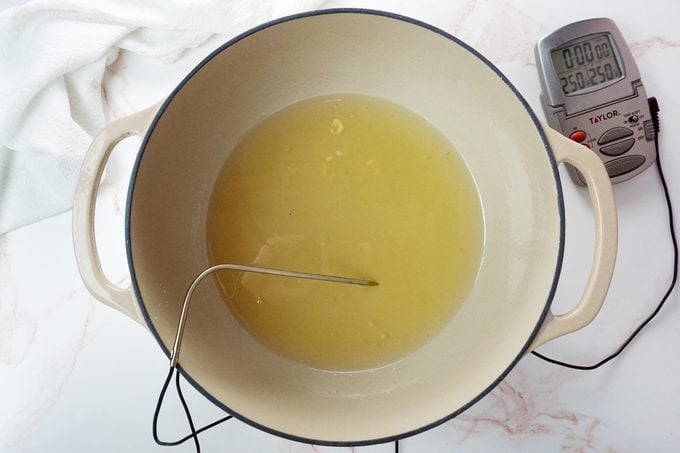 Lauren Habermehl for taste of home
Lauren Habermehl for taste of home
Bring the mixture to a low boil then reduce heat and simmer over medium-low heat until the mixture reaches 250°F. You’re looking for the syrup to reach what’s known as the “hard ball” stage in candy making. It should take about 20-25 minutes to achieve this temperature.
Editor’s Tip: If you do not own one, definitely invest in a candy thermometer or an instant-read thermometer for this recipe. It’s absolutely necessary in order to avoid candy-making mistakes. The syrup needs to be heated to the perfect temperature to ensure the final texture of the Turkish delights is correct once they’re set.
Step 3: Whisk
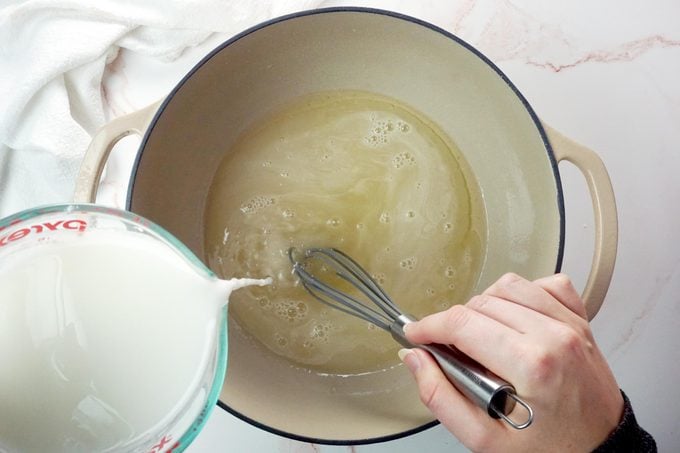 Lauren Habermehl for taste of home
Lauren Habermehl for taste of home
In a glass measuring cup, whisk the cornstarch and remaining 2 cups of water together until fully dissolved.
Once the syrup hits 250°F, remove the pot from the heat and whisk the cornstarch mixture into the syrup until fully incorporated.
Step 4: Thicken
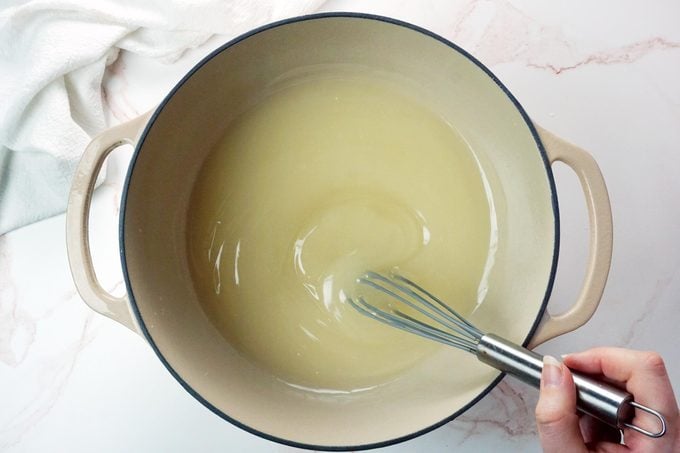 Lauren Habermehl for taste of home
Lauren Habermehl for taste of home
Return the pot to the stovetop over medium-low heat. Stir continuously until the mixture thickens and begins to bubble, about 5 to 8 minutes.
Step 5: Cook
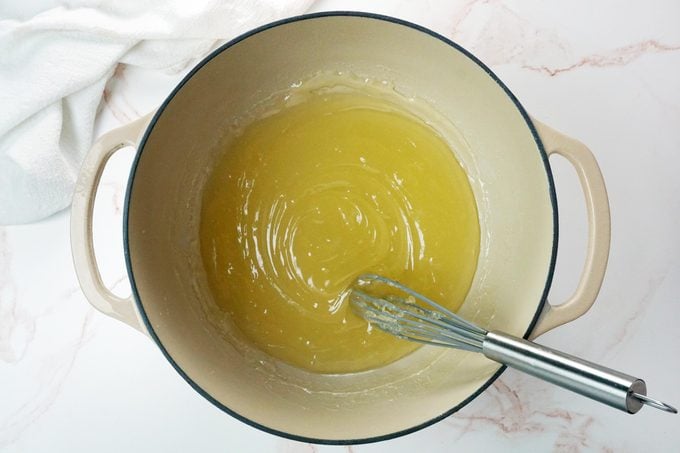 Lauren Habermehl for taste of home
Lauren Habermehl for taste of home
Reduce the heat to low, so the mixture is just barely simmering. Let cook for 1-1/2 to 2 hours, stirring every 5 to 6 minutes to keep the mixture smooth and prevent it from clumping.
Step 6: Prepare Mold
While the mixture cooks, lightly oil the bottom and sides of a 7×5-inch rectangular glass container (like a Pyrex) with vegetable oil.
Editor’s Tip: In testing, we also tried out a 1-inch square silicone ice cube tray. This worked fantastically for molding the Turkish delights into perfectly even cubes and omitted the need for cutting with a knife.
Step 7: Check color and consistency
Around the 1 hour and 15 minutes mark, start keeping a close eye on the color and consistency of the mixture. It is ready when it becomes thick, gelatinous and is a medium-light shade of gold. For us, this happened around 1 hour and 45 minutes. Yours, however, may be ready sooner or need longer depending on the pan you are using and the heat output of your burner.
Step 8: Add color and flavoring
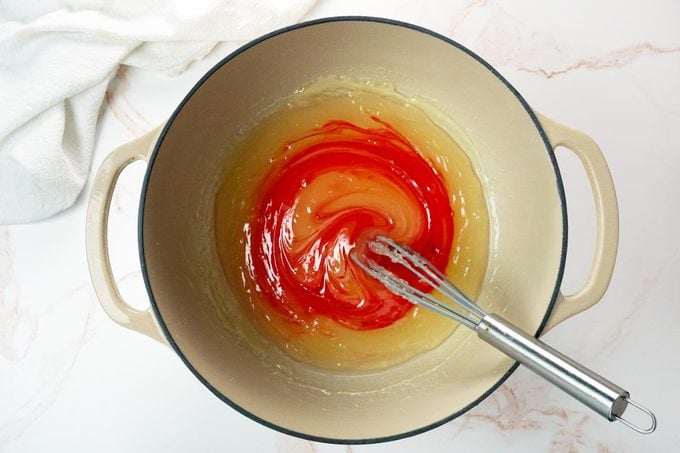 Lauren Habermehl for taste of home
Lauren Habermehl for taste of home
Remove the mixture from the heat and stir in the food coloring and rose water.
Editor’s Tip: If rose is not your favorite flavor, you can swap the rose water and red food coloring for orange or lemon extract, and either orange or yellow food coloring. A bit of lemon zest or orange zest makes a nice addition too.
Step 9: Pour
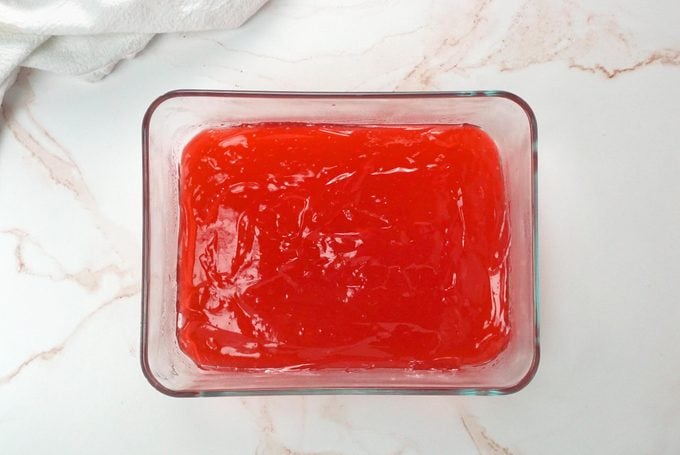 Lauren Habermehl for taste of home
Lauren Habermehl for taste of home
Transfer the mixture to your prepared mold, spreading it into an even layer. Let the mixture cool and rest at room temperature until it is fully set, about 3 hours or overnight for best results.
Step 10: Unmold
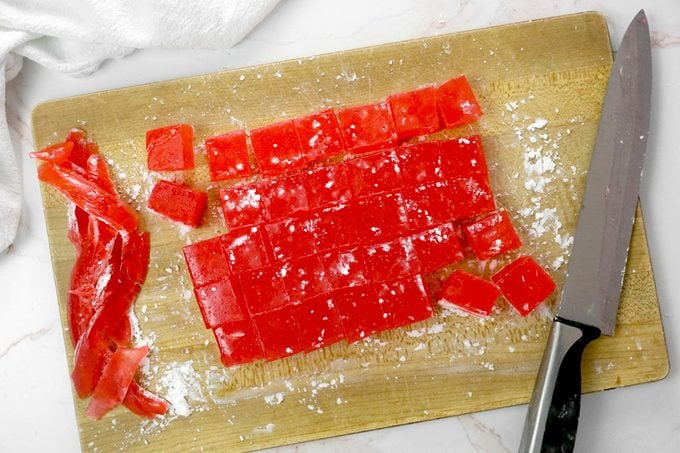 Lauren Habermehl for taste of home
Lauren Habermehl for taste of home
Dust the top of the molded Turkish delight with a bit of cornstarch. Then, run a knife around the edge of the mold to loosen the slab. Carefully lift the candy from the container and place it on a clean surface dusted with cornstarch. Cut into 1-inch cubes using a lightly oiled sharp knife.
Editor’s Tip: If using an ice cube mold, dust the top of the cubes with cornstarch and then gently unmold each cube onto a cornstarch-dusted surface.
Step 11: Coat
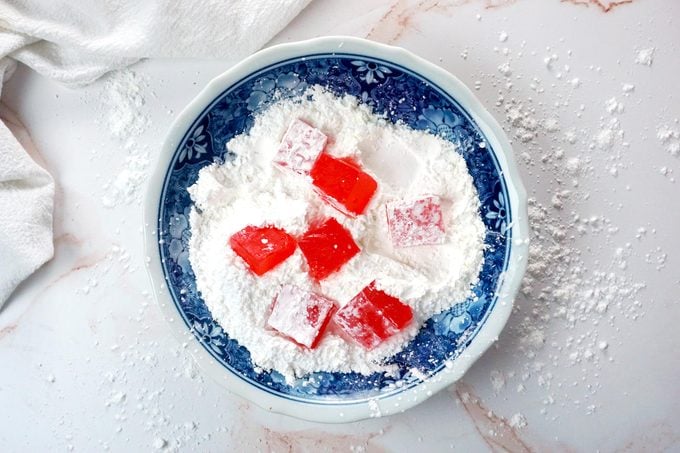 Lauren Habermehl for taste of home
Lauren Habermehl for taste of home
In a shallow bowl, combine the confectioners’ sugar (try making your own) and cornstarch. Roll each cube through the mixture until evenly coated on all sides.
Step 12: Enjoy
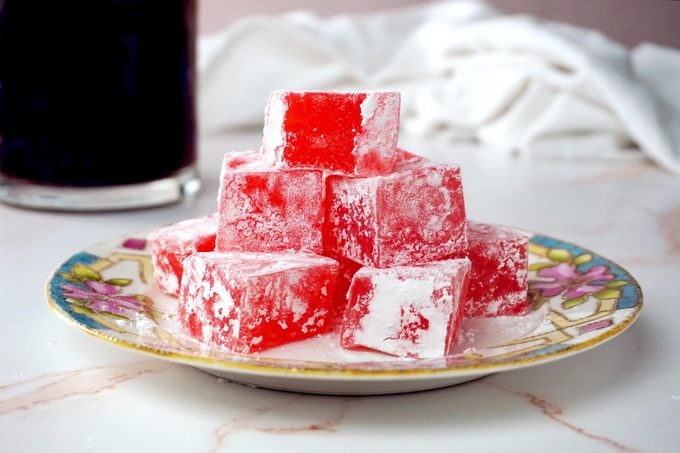 Lauren Habermehl for taste of home
Lauren Habermehl for taste of home
Arrange on a platter and serve with Turkish coffee or hot tea.
You can store Turkish delights in a covered container in the fridge with additional cornstarch and powdered sugar dusted over them for up to 10 days. Allow the candies to come to room temperature before serving.
Where to Watch ‘The Lion, The Witch and The Wardrobe’
Forget the wardrobe. A batch of these Turkish Delights and a subscription to Disney+ is all you need to be transported straight to Narnia. Just look out for the White Witch. We hear she too is partial to a freshly made Turkish Delight!
Our Favorite Homemade Candy Recipes
Grandma’s Divinity
Every Christmas my grandmother and I made divinity, just the two of us. I still make it every year. —Anne Clayborne, Walland, Tennessee
Get Recipe
(Check out our full guide to
how to make candy for tips, tools and more!)
Peanut Butter Fudge CupsMy husband often travels during the week, and this fast-to-fix microwave peanut butter fudge recipe is perfect for just my 2-year-old and me. —Lori Brow, Manhattan, Illinois.
Chocoholics will love our
chocolate candy recipes!
Chocolate BonbonsMy grandmother gave me this tasty chocolate bonbons recipe when I was a girl. Some of my fondest childhood memories are of her huge kitchen and all the delicious treats she made. —Joan Lewis, Reno, Nevada
PacocaPacoca (Brazilian peanut candy) is an easy treat that has only five ingredients! It's a popular sweet in Brazil, and after you try it, I'm sure you'll love it, too. —Francine Lizotte, Surrey, British Columbia
By the way, here's
how to melt chocolate five easy ways.
Perfect Peppermint PattiesCalling for just a few ingredients, this is one candy that's simple to prepare. I make lots of different candy at Christmas to give as gifts. It's time consuming, but worth it to see the delight it brings to people.
-Joanne Adams, Bath, Maine
By the way, here's
how to temper chocolate.
Birthday Cake FudgeThis decadent birthday cake fudge is the perfect thing to make your big day special. Or make it ahead and package it as a surprise gift for a friend. —Rashanda Cobbins, Milwaukee, Wisconsin
Make sure you avoid these common
fudge mistakes.
Chocolate-Covered CherriesNot only is this my family's favorite festive dessert, but it makes a delicious holiday present, too. Best of all, you can (and should) prepare these ahead. The candy gets better as it's stored, with the centers becoming even juicier. —Linda Hammerich, Bonanza, Oregon
Haystack Cookies with Peanut ButterPeanut butter haystacks are one of my favorite desserts. I love to serve them to guests because they marvel at how something so simple tastes so good! —Starrlette Howard, Ogden, Utah
Perfect Chocolate FudgeThis rich chocolate fudge is sure to delight someone you love. —Dorothy Anderson, Ottawa, Kansas
Bourbon Pecan PralinesLike authentic pecan pralines found in New Orleans, these treats are sweet, crunchy and rich! —Taste of Home Test Kitchen
If you want candy with a wintry angle, take a look at these
homemade Christmas candy recipes.
BuckeyesThese
chocolate peanut butter balls (no bake!) are always popular at my church's annual Christmas fundraiser. They resemble chestnuts or buckeyes—hence the name. —Merry Kay Opitz, Elkhorn, Wisconsin
Pumpkin Seed ToffeeMy kids are allergic to nuts, but they can eat pumpkin seeds! Every fall we save the seeds from our pumpkins to add to various recipes, including this one. —Suzanne Earl, Spring, Texas
Chocolate-Covered PretzelsThese chocolate-covered pretzels came from my grandma, who loves to make candy and treats for my students. I have followed in her footsteps and make these for people at work and for other family members. —Aimee Worth, Fair Oaks, California
Chocolate Angel Food CandyIf you love angel food cake, you are going to love this candy. The taste is irresistible. —Geralyn Emmerich, Hubertus, Wisconsin
You'll want to stuff stockings with our
best Christmas candy recipes.
Crispy Peanut Butter BallsI make over 40 different types of treats during the holidays for friends and family. These crispy peanut butter balls are one of my favorite candies to give away as gifts.—Liz David, St. Catharines, Ontario
Cranberry Butter Crunch BarkOne Christmas I dreamed this recipe up when making buttercrunch toffee. It is an addictive treat that disappears fast.—Heather Ferris, Vanderhoof, British Columbia
Homemade Mango MarshmallowsHomemade marshmallows are much better than bagged ones. I had yummy results when I flavored my recipe with mango nectar. Look for it in your store’s Mexican food section. —Deirdre Cox, Kansas City, Missouri
Maine Potato CandyYears ago, folks in Maine ate potatoes daily and used leftovers in bread, doughnuts and other dishes. This potato candy recipe captures all of the old-school flavors. —Barbara Allen, Chelmsford, Massachusetts
Microwave DivinityNot only is this the best-tasting divinity recipe I've ever made, it's the easiest! Try it with and without the pecans. —LaDonna Reed, Ponca City, Oklahoma
Candied PecansI pack these easy candied pecans in jars tied with pretty ribbon for family and friends. My granddaughter gave some to a doctor at the hospital where she works, and he said they were too good to be true! —Opal Turner, Hughes Springs, Texas
Banana Cream Chocolate TrufflesThis truffle recipe was created from ripe bananas and my imagination, and the outcome blew my family and friends away! I don’t particularly like bananas, but I could eat these truffles all day long. —Michele, Lassuy, Orlando, Florida
(Check out these
tips for making chocolate truffles!)
Chocolate Pomegranate CandiesThis recipe pairs white and dark chocolate with whole, natural ingredients for an unbelievably delicious treat! These candies are perfect to give as a gift for Christmas. —Kelly Zdrowak, Orchard Park, New York
Angel Food Christmas CandyIt was my dad who inspired me to first try making this
Christmas candy. He remembered it from when he was a boy. The ultimate compliment was when he told me my version tasted even better!
Pumpkin FudgeI look forward to the taste of pumpkin every Thanksgiving. This easy pumpkin fudge recipe lets me do that and everyone loves it.—Marlene Fudge, Rushville, Indiana
Caramel TrufflesThese candies disappear as fast as I can make them. The five-ingredient microwave recipe is easy and fun to make. When drizzled with white chocolate and packaged with ribbon, they're a pretty gift. —Charlotte Midthun, Granite Falls, Minnesota
Salted Peanut SquaresIf your gift list is long, here’s a yummy solution. The recipe makes nearly 10 dozen chewy, nutty, sweet-and-salty bars.
Creamy CaramelsI discovered this caramel recipe in a local newspaper years ago and have made these soft buttery caramels ever since. I make them for Christmas, picnics and charity auctions—and they are so much better than store-bought caramels. Once people have a taste, they ask for the recipe. —Marcie Wolfe, Williamsburg, Virginia
Dark Chocolate Raspberry FudgeSomething about the combination of dark chocolate and raspberry is just so addicting. This fudge makes a heartfelt homemade gift, or just a treat that's worth sharing. —Barbara Lento, Houston, Pennsylvania
Orange GumdropsI get nothing but rave reviews when I make these gumdrops and usually have to prepare three batches. The refreshing orange flavor is a nice change from the usual chocolate holiday candies. —Becky Burch, Marceline, Missouri
Peanut Butter LogsThese peanut butter logs have definitely stood the test of time. My husband has been enjoying them since he was a toddler! —Micky Faginkrantz, Ft. Bliss, Texas
Chocolate Cherry FudgeThis chocolate cherry fudge is unique from others, and festive for the holidays. It's a recipe my husband really enjoys. I've made it for our Homemaker group's Christmas party. —June Lindquist, Hammond, Wisconsin
Chocolaty Peanut ClustersI turn to my slow cooker to prepare these convenient chocolate treats. Making candies couldn't be any easier! —Pam Posey, Waterloo, South Carolina
Coconut Creme ChocolatesI'm a proud wife, mom of three and grandma of many. I've cooked many things over the years, including these marshmallowy chocolates. —Dolores Wilder, Texas City, Texas
Martha Washington CandyPassed down by my grandmother and mother, this Martha Washington candy recipe is a cherished family tradition. We've even had each grandchild and great-grandchild take a turn stirring the candy mixture! —Cindi Boger, Ardmore, Alabama
Potato Chip ClustersJust three offbeat ingredients add up to one unique, delectable, no-bake treat. These super easy, sweet-and-salty candy clusters make for merry munching during holiday trips or parties. They travel well in containers without melting or getting soft. —Donna Brockett, Kingfisher, Oklahoma
Anise GumdropsWith their bright color and frosty sugared look, these homemade gumdrops are irresistible. They're softer than the store-bought kind and have tongue-tingling anise flavor. —Richard Bunt, Painted Post, New York
Black Cherry Swirl FudgeThis colorful treat is sure to satisfy the sweetest tooth in any family! It's always been a favorite with my nine kids, eight grandkids and my Bible study group. I vary the soft-drink flavors to get colors that match other holidays during the year. —Pauletta Bushnell, Lebanon, Oregon
Pretzel Bark CandyI usually make this pretzel candy as a gift, but it's also fun to share at office parties. The recipe makes a big batch and stores well. —Betty Claycomb, Alverton, Pennsylvania
Chocolate Peanut Butter CandyWith only three ingredients, these chocolate-swirl treats take just moments to whip up! If you have little ones visiting for the holidays, have them help you with the stirring. —Holly Demers, Abbotsford, British Columbia
Aunt Rose's Fantastic Butter ToffeeI don't live in the country, but I love everything about it—especially good old-fashioned home cooking! Every year, you'll find me at our county fair, entering a different contest. This easy toffee recipe is a family favorite. —Kathy Dorman, Snover, Michigan
Coconut JoysIf you like coconut, you’ll love these no-bake, no-fuss sweets. They are cute as can be and make a satisfying after-school snack to keep in the fridge. —Flo Burtnett, North Gage, Oklahoma
Old-Time Butter Crunch CandyBoth my children and my grandchildren say the season wouldn't be the same without the big tray of candies and cookies I prepare. This one's the most popular part of that collection. We love the nutty pieces draped in chocolate. —Mildred Duffy, Bella Vista, Arkansas
Creamy Peppermint PattiesThese smooth chocolate candies fill the bill for folks who like a little sweetness after a meal but don't want a full serving of rich dessert. —Donna Gonda, North Canton, Ohio
Kahlua FudgeThis five-ingredient recipe makes serving up treats easy and scrumptious. —Laura Hanks, Harleysville, Pennsylvania
Homemade Peanut Butter CupsI like using pretty mini muffin liners and topping these homemade peanut butter cups with colored sprinkles to coordinate with the holiday we're celebrating. People can't believe how simple it is to make this irresistible candy with gooey peanut butter centers. This is how to make homemade peanut butter cups. —LaVonne Hegland, St. Michael, Minnesota
Chocolate BillionairesEveryone raves about these chocolate and caramel candies. I received the recipe from a friend while living in Texas. When we moved, I made sure this recipe made the trip with me! —June Humphrey, Strongsville, Ohio
Chocolate Pecan CaramelsI haven't missed a year making this candy for the holidays since a friend gave me the recipe in 1964! It is made like a pan of upside-down bars and tastes like my favorite caramel pecan candies. We are natives of the Lone Star State who moved to Ohio when my husband was transferred several years ago. —June Humphrey, Strongsville, Ohio
Texas Pecan PralinesMy pecan praline recipe is special to me for I received it from my mother, who was an excellent cook! I also am a Texas Aggie Mom and I use pecans from a South Texas Aggie grower that our Aggie Mom's club has purchased from for many years. The quality is outstanding and far better than you will find in any grocery store. —Carol Jones, Blue Ridge, Texas
Caramel Pretzel BitesI created this recipe wanting to make my own version of a popular candy store pretzel log dipped in caramel, chocolate and nuts. These bites are smothered with homemade caramel. —Michilene Klaver, Grand Rapids, Michigan
Cookies 'n' Cream FudgeI invented this confection for a bake sale at our children's school. Boy, was it a hit! The crunchy chunks of sandwich cookie soften a bit as the mixture mellows. It's so sweet that one panful serves a crowd. —Laura Lane, Richmond, Virginia
White Chocolate TrufflesI use this white chocolate truffle recipe to make homemade holiday gifts. The candies are so easy to make and will look so pretty in a gift box.—Gloria Nolan, Peoria, Pennsylvania
Curry-Kissed Coconut FudgeIf you love Thai flavors and love fudge, you'll adore this creamy coconut fudge sprinkled with a hint of sweet curry powder. —Sarah Meuser, New Milford, Connecticut
Trail Mix ClustersThese delicious snacks make wonderful gifts, and although they look and taste like they came from an expensive chocolate shop, they couldn't be more guilt-free. The dried fruit and nuts are heart-healthy and full of fiber. Bet you can't eat just one! —Alina Niemi, Honolulu, Hawaii
Crunchy Candy ClustersThese cereal and marshmallow clusters are so simple that I make them for the holidays each year, as my family looks forward to them. —Faye O'Bryan, Owensboro, Kentucky
Three-Chip English ToffeeWith its melt-in-your-mouth texture and scrumptiously rich flavor, this is the ultimate toffee! Layered on top are three kinds of melted chips plus a sprinkling of walnuts. Packaged in colorful tins, these pretty pieces make impressive gifts. —Lana Petfield, Richmond, Virginia
No-Bake Peanut Butter TreatsPerfect for road trips, these peanut butter oatmeal balls won’t stick to your hands. Keep them in the refrigerator for portable snacks. —Sonia Rohda, Waverly, Nebraska
Easy Peanut Butter FudgeMy sister shared the recipe for this unbelievably easy peanut butter fudge with marshmallow cream. I prefer using creamy peanut butter for this mouthwatering dessert, but the chunky style works just as well. —Mary Jane Rummel, Linglestown, Pennsylvania
Soft Chewy CaramelsOne of my first experiences with cooking was helping my mother make these caramels. We'd make up to 12 batches each year. Today, I do at least 95 percent of the cooking at home, but my wife does much of the baking. —Robert Sprenkle, Hurst, Texas
Nut Butter CupsMy indulgent, nutty treat is simple to make and looks fabulous. At our house, we use all-natural ingredients for them. —Courtney Stultz, Weir, Kansas
Almond Cherry FudgeCooked in the microwave, this fast fudge is a sweet addition to any holiday gathering. I make it when I need a quick treat for a school party or to take to a neighbor. —Shellie Tucker, Hendersonvlle, Tennessee
Marbled Orange FudgeThis decadent treat doesn't last long at our house. The Creamsicle flavor of this soft fudge brings on the smiles. Bright orange and marshmallow swirls make it a perfect takealong for events and get-togethers. —Diane Wampler, Morristown, Tennessee
Chocolate TrufflesYou may be tempted to save these chocolate truffles for a special occasion since these smooth, creamy chocolates are divine. But with just a few ingredients, this truffle recipe is easy to make anytime. —Darlene Wiese-Appleby, Creston, Ohio
Lemon BarkI wasn't a fan of white chocolate until I made this candy. It's tangy, sweet and creamy all at the same time. The bark was a lovely treat during a springtime shower but would be nice year-round. —Diana Wing, Bountiful, Utah
Fun fact: peppermint bark happens to be one of the
most popular Christmas candy options in several states.
Chocolate-Covered Peanut Butter & Pretzel TrufflesSweet chocolate, creamy peanut butter and salty pretzels create a to-die-for truffle. It’s a little bite of decadence and a special indulgence for the holiday season.—Ashley Wisniewski, Champaign, Illinois
Matzo ToffeeOnce you start eating matzo toffee, you may not be able to stop! Matzo crackers are topped with buttery caramel, chocolate and slivered almonds and then baked to perfection. —Sharalyn Zander, Jacksonville, Alabama














